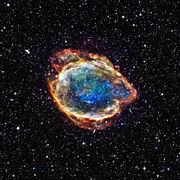Star
A star is a luminous spheroid of plasma held together by self-gravity.[1] The nearest star to Earth is the Sun. Many other stars are visible to the naked eye at night; their immense distances from Earth make them appear as fixed points of light. The most prominent stars have been categorised into constellations and asterisms, and many of the brightest stars have proper names. Astronomers have assembled star catalogues that identify the known stars and provide standardized stellar designations. The observable universe contains an estimated 1022 to 1024 stars. Only about 4,000 of these stars are visible to the naked eye—all within the Milky Way galaxy.[2]
A star's life begins with the gravitational collapse of a gaseous nebula of material largely comprising hydrogen, helium, and trace heavier elements. Its total mass mainly determines its evolution and eventual fate. A star shines for most of its active life due to the thermonuclear fusion of hydrogen into helium in its core. This process releases energy that traverses the star's interior and radiates into outer space. At the end of a star's lifetime, fusion ceases and its core becomes a stellar remnant: a white dwarf, a neutron star, or—if it is sufficiently massive—a black hole.
Stellar nucleosynthesis in stars or their remnants creates almost all naturally occurring chemical elements heavier than lithium. Stellar mass loss or supernova explosions return chemically enriched material to the interstellar medium. These elements are then recycled into new stars. Astronomers can determine stellar properties—including mass, age, metallicity (chemical composition), variability, distance, and motion through space—by carrying out observations of a star's apparent brightness, spectrum, and changes in its position in the sky over time.
Stars can form orbital systems with other astronomical objects, as in planetary systems and star systems with two or more stars. When two such stars orbit closely, their gravitational interaction can significantly impact their evolution. Stars can form part of a much larger gravitationally bound structure, such as a star cluster or a galaxy.
Etymology
The word "star" ultimately derives from the Proto-Indo-European root "h₂stḗr" also meaning star, but further analyzable as h₂eh₁s- ("to burn", also the source of the word "ash") + -tēr (agentive suffix). Compare Latin stella, Greek aster, German Stern. Some scholars[who?] believe the word is a borrowing from Akkadian "istar" (Venus). "Star" is cognate (shares the same root) with the following words: asterisk, asteroid, astral, constellation, Esther.[3]
Observation history
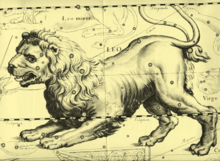
Historically, stars have been important to civilizations throughout the world. They have been part of religious practices, divination rituals, mythology, used for celestial navigation and orientation, to mark the passage of seasons, and to define calendars.
Early astronomers recognized a difference between "fixed stars", whose position on the celestial sphere does not change, and "wandering stars" (planets), which move noticeably relative to the fixed stars over days or weeks.[6] Many ancient astronomers believed that the stars were permanently affixed to a heavenly sphere and that they were immutable. By convention, astronomers grouped prominent stars into asterisms and constellations and used them to track the motions of the planets and the inferred position of the Sun.[4] The motion of the Sun against the background stars (and the horizon) was used to create calendars, which could be used to regulate agricultural practices.[7] The Gregorian calendar, currently used nearly everywhere in the world, is a solar calendar based on the angle of the Earth's rotational axis relative to its local star, the Sun.
The oldest accurately dated star chart was the result of ancient Egyptian astronomy in 1534 BC.[8] The earliest known star catalogues were compiled by the ancient Babylonian astronomers of Mesopotamia in the late 2nd millennium BC, during the Kassite Period (c. 1531 BC – c. 1155 BC).[9]
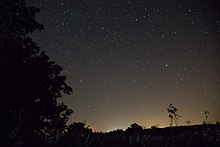
The first star catalogue in Greek astronomy was created by Aristillus in approximately 300 BC, with the help of Timocharis.[10] The star catalog of Hipparchus (2nd century BC) included 1,020 stars, and was used to assemble Ptolemy's star catalogue.[11] Hipparchus is known for the discovery of the first recorded nova (new star).[12] Many of the constellations and star names in use today derive from Greek astronomy.
Despite the apparent immutability of the heavens, Chinese astronomers were aware that new stars could appear.[13] In 185 AD, they were the first to observe and write about a supernova, now known as SN 185.[14] The brightest stellar event in recorded history was the SN 1006 supernova, which was observed in 1006 and written about by the Egyptian astronomer Ali ibn Ridwan and several Chinese astronomers.[15] The SN 1054 supernova, which gave birth to the Crab Nebula, was also observed by Chinese and Islamic astronomers.[16][17][18]
Medieval Islamic astronomers gave Arabic names to many stars that are still used today and they invented numerous astronomical instruments that could compute the positions of the stars. They built the first large observatory research institutes, mainly to produce Zij star catalogues.[19] Among these, the Book of Fixed Stars (964) was written by the Persian astronomer Abd al-Rahman al-Sufi, who observed a number of stars, star clusters (including the Omicron Velorum and Brocchi's Clusters) and galaxies (including the Andromeda Galaxy).[20] According to A. Zahoor, in the 11th century, the Persian polymath scholar Abu Rayhan Biruni described the Milky Way galaxy as a multitude of fragments having the properties of nebulous stars, and gave the latitudes of various stars during a lunar eclipse in 1019.[21]
According to Josep Puig, the Andalusian astronomer Ibn Bajjah proposed that the Milky Way was made up of many stars that almost touched one another and appeared to be a continuous image due to the effect of refraction from sublunary material, citing his observation of the conjunction of Jupiter and Mars on 500 AH (1106/1107 AD) as evidence.[22] Early European astronomers such as Tycho Brahe identified new stars in the night sky (later termed novae), suggesting that the heavens were not immutable. In 1584, Giordano Bruno suggested that the stars were like the Sun, and may have other planets, possibly even Earth-like, in orbit around them,[23] an idea that had been suggested earlier by the ancient Greek philosophers, Democritus and Epicurus,[24] and by medieval Islamic cosmologists[25] such as Fakhr al-Din al-Razi.[26] By the following century, the idea of the stars being the same as the Sun was reaching a consensus among astronomers. To explain why these stars exerted no net gravitational pull on the Solar System, Isaac Newton suggested that the stars were equally distributed in every direction, an idea prompted by the theologian Richard Bentley.[27]
The Italian astronomer Geminiano Montanari recorded observing variations in luminosity of the star Algol in 1667. Edmond Halley published the first measurements of the proper motion of a pair of nearby "fixed" stars, demonstrating that they had changed positions since the time of the ancient Greek astronomers Ptolemy and Hipparchus.[23]
William Herschel was the first astronomer to attempt to determine the distribution of stars in the sky. During the 1780s, he established a series of gauges in 600 directions and counted the stars observed along each line of sight. From this, he deduced that the number of stars steadily increased toward one side of the sky, in the direction of the Milky Way core. His son John Herschel repeated this study in the southern hemisphere and found a corresponding increase in the same direction.[28] In addition to his other accomplishments, William Herschel is noted for his discovery that some stars do not merely lie along the same line of sight, but are physical companions that form binary star systems.[29]
The science of stellar spectroscopy was pioneered by Joseph von Fraunhofer and Angelo Secchi. By comparing the spectra of stars such as Sirius to the Sun, they found differences in the strength and number of their absorption lines—the dark lines in stellar spectra caused by the atmosphere's absorption of specific frequencies. In 1865, Secchi began classifying stars into spectral types.[30] The modern version of the stellar classification scheme was developed by Annie J. Cannon during the early 1900s.[31]
The first direct measurement of the distance to a star (61 Cygni at 11.4 light-years) was made in 1838 by Friedrich Bessel using the parallax technique. Parallax measurements demonstrated the vast separation of the stars in the heavens.[23] Observation of double stars gained increasing importance during the 19th century. In 1834, Friedrich Bessel observed changes in the proper motion of the star Sirius and inferred a hidden companion. Edward Pickering discovered the first spectroscopic binary in 1899 when he observed the periodic splitting of the spectral lines of the star Mizar in a 104-day period. Detailed observations of many binary star systems were collected by astronomers such as Friedrich Georg Wilhelm von Struve and S. W. Burnham, allowing the masses of stars to be determined from computation of orbital elements. The first solution to the problem of deriving an orbit of binary stars from telescope observations was made by Felix Savary in 1827.[32]
The twentieth century saw increasingly rapid advances in the scientific study of stars. The photograph became a valuable astronomical tool. Karl Schwarzschild discovered that the color of a star and, hence, its temperature, could be determined by comparing the visual magnitude against the photographic magnitude. The development of the photoelectric photometer allowed precise measurements of magnitude at multiple wavelength intervals. In 1921 Albert A. Michelson made the first measurements of a stellar diameter using an interferometer on the Hooker telescope at Mount Wilson Observatory.[33]
Important theoretical work on the physical structure of stars occurred during the first decades of the twentieth century. In 1913, the Hertzsprung-Russell diagram was developed, propelling the astrophysical study of stars. Successful models were developed to explain the interiors of stars and stellar evolution. Cecilia Payne-Gaposchkin first proposed that stars were made primarily of hydrogen and helium in her 1925 PhD thesis.[34] The spectra of stars were further understood through advances in quantum physics. This allowed the chemical composition of the stellar atmosphere to be determined.[35]
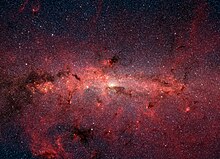
With the exception of rare events such as supernovae and supernova impostors, individual stars have primarily been observed in the Local Group,[36] and especially in the visible part of the Milky Way (as demonstrated by the detailed star catalogues available for the Milky Way galaxy) and its satellites.[37] Individual stars such as Cepheid variables have been observed in the M87[38] and M100 galaxies of the Virgo Cluster,[39] as well as luminous stars in some other relatively nearby galaxies.[40] With the aid of gravitational lensing, a single star (named Icarus) has been observed at 9 billion light-years away.[41][42]
Designations
The concept of a constellation was known to exist during the Babylonian period. Ancient sky watchers imagined that prominent arrangements of stars formed patterns, and they associated these with particular aspects of nature or their myths. Twelve of these formations lay along the band of the ecliptic and these became the basis of astrology.[43] Many of the more prominent individual stars were given names, particularly with Arabic or Latin designations.
As well as certain constellations and the Sun itself, individual stars have their own myths.[44] To the Ancient Greeks, some "stars", known as planets (Greek πλανήτης (planētēs), meaning "wanderer"), represented various important deities, from which the names of the planets Mercury, Venus, Mars, Jupiter and Saturn were taken.[44] (Uranus and Neptune were Greek and Roman gods, but neither planet was known in Antiquity because of their low brightness. Their names were assigned by later astronomers.)
Circa 1600, the names of the constellations were used to name the stars in the corresponding regions of the sky. The German astronomer Johann Bayer created a series of star maps and applied Greek letters as designations to the stars in each constellation. Later a numbering system based on the star's right ascension was invented and added to John Flamsteed's star catalogue in his book "Historia coelestis Britannica" (the 1712 edition), whereby this numbering system came to be called Flamsteed designation or Flamsteed numbering.[45][46]
The internationally recognized authority for naming celestial bodies is the International Astronomical Union (IAU).[47] The International Astronomical Union maintains the Working Group on Star Names (WGSN)[48] which catalogs and standardizes proper names for stars.[49] A number of private companies sell names of stars which are not recognized by the IAU, professional astronomers, or the amateur astronomy community.[50] The British Library calls this an unregulated commercial enterprise,[51][52] and the New York City Department of Consumer and Worker Protection issued a violation against one such star-naming company for engaging in a deceptive trade practice.[53][54]
Units of measurement
Although stellar parameters can be expressed in SI units or Gaussian units, it is often most convenient to express mass, luminosity, and radii in solar units, based on the characteristics of the Sun. In 2015, the IAU defined a set of nominal solar values (defined as SI constants, without uncertainties) which can be used for quoting stellar parameters:
nominal solar luminosity L☉ = 3.828×1026 W[55] nominal solar radius R☉ = 6.957×108 m[55]
The solar mass M☉ was not explicitly defined by the IAU due to the large relative uncertainty (10−4) of the Newtonian constant of gravitation G. Since the product of the Newtonian constant of gravitation and solar mass together (GM☉) has been determined to much greater precision, the IAU defined the nominal solar mass parameter to be:
nominal solar mass parameter: GM☉ = 1.3271244×1020 m3/s2[55]
The nominal solar mass parameter can be combined with the most recent (2014) CODATA estimate of the Newtonian constant of gravitation G to derive the solar mass to be approximately 1.9885×1030 kg. Although the exact values for the luminosity, radius, mass parameter, and mass may vary slightly in the future due to observational uncertainties, the 2015 IAU nominal constants will remain the same SI values as they remain useful measures for quoting stellar parameters.
Large lengths, such as the radius of a giant star or the semi-major axis of a binary star system, are often expressed in terms of the astronomical unit—approximately equal to the mean distance between the Earth and the Sun (150 million km or approximately 93 million miles). In 2012, the IAU defined the astronomical constant to be an exact length in meters: 149,597,870,700 m.[55]
Formation and evolution
Stars condense from regions of space of higher matter density, yet those regions are less dense than within a vacuum chamber. These regions—known as molecular clouds—consist mostly of hydrogen, with about 23 to 28 percent helium and a few percent heavier elements. One example of such a star-forming region is the Orion Nebula.[56] Most stars form in groups of dozens to hundreds of thousands of stars.[57] Massive stars in these groups may powerfully illuminate those clouds, ionizing the hydrogen, and creating H II regions. Such feedback effects, from star formation, may ultimately disrupt the cloud and prevent further star formation.[58] All stars spend the majority of their existence as main sequence stars, fueled primarily by the nuclear fusion of hydrogen into helium within their cores. However, stars of different masses have markedly different properties at various stages of their development. The ultimate fate of more massive stars differs from that of less massive stars, as do their luminosities and the impact they have on their environment. Accordingly, astronomers often group stars by their mass:[59]
- Very low mass stars, with masses below 0.5 M☉, are fully convective and distribute helium evenly throughout the whole star while on the main sequence. Therefore, they never undergo shell burning and never become red giants. After exhausting their hydrogen they become helium white dwarfs and slowly cool.[60] As the lifetime of 0.5 M☉ stars is longer than the age of the universe, no such star has yet reached the white dwarf stage.
- Low mass stars (including the Sun), with a mass between 0.5 M☉ and ~2.25 M☉ depending on composition, do become red giants as their core hydrogen is depleted and they begin to burn helium in core in a helium flash; they develop a degenerate carbon-oxygen core later on the asymptotic giant branch; they finally blow off their outer shell as a planetary nebula and leave behind their core in the form of a white dwarf.[61][62]
- Intermediate-mass stars, between ~2.25 M☉ and ~8 M☉, pass through evolutionary stages similar to low mass stars, but after a relatively short period on the red-giant branch they ignite helium without a flash and spend an extended period in the red clump before forming a degenerate carbon-oxygen core.[61][62]
- Massive stars generally have a minimum mass of ~8 M☉.[63] After exhausting the hydrogen at the core these stars become supergiants and go on to fuse elements heavier than helium. Many end their lives when their cores collapse and they explode as supernovae.[61][64]
Star formation
The formation of a star begins with gravitational instability within a molecular cloud, caused by regions of higher density—often triggered by compression of clouds by radiation from massive stars, expanding bubbles in the interstellar medium, the collision of different molecular clouds, or the collision of galaxies (as in a starburst galaxy).[65][66] When a region reaches a sufficient density of matter to satisfy the criteria for Jeans instability, it begins to collapse under its own gravitational force.[67]
As the cloud collapses, individual conglomerations of dense dust and gas form "Bok globules". As a globule collapses and the density increases, the gravitational energy converts into heat and the temperature rises. When the protostellar cloud has approximately reached the stable condition of hydrostatic equilibrium, a protostar forms at the core.[68] These pre-main-sequence stars are often surrounded by a protoplanetary disk and powered mainly by the conversion of gravitational energy. The period of gravitational contraction lasts about 10 million years for a star like the sun, up to 100 million years for a red dwarf.[69]
Early stars of less than 2 M☉ are called T Tauri stars, while those with greater mass are Herbig Ae/Be stars. These newly formed stars emit jets of gas along their axis of rotation, which may reduce the angular momentum of the collapsing star and result in small patches of nebulosity known as Herbig–Haro objects.[70][71] These jets, in combination with radiation from nearby massive stars, may help to drive away the surrounding cloud from which the star was formed.[72]
Early in their development, T Tauri stars follow the Hayashi track—they contract and decrease in luminosity while remaining at roughly the same temperature. Less massive T Tauri stars follow this track to the main sequence, while more massive stars turn onto the Henyey track.[73]
Most stars are observed to be members of binary star systems, and the properties of those binaries are the result of the conditions in which they formed.[74] A gas cloud must lose its angular momentum in order to collapse and form a star. The fragmentation of the cloud into multiple stars distributes some of that angular momentum. The primordial binaries transfer some angular momentum by gravitational interactions during close encounters with other stars in young stellar clusters. These interactions tend to split apart more widely separated (soft) binaries while causing hard binaries to become more tightly bound. This produces the separation of binaries into their two observed populations distributions.[75]
Main sequence
Stars spend about 90% of their lifetimes fusing hydrogen into helium in high-temperature-and-pressure reactions in their cores. Such stars are said to be on the main sequence and are called dwarf stars. Starting at zero-age main sequence, the proportion of helium in a star's core will steadily increase, the rate of nuclear fusion at the core will slowly increase, as will the star's temperature and luminosity.[76] The Sun, for example, is estimated to have increased in luminosity by about 40% since it reached the main sequence 4.6 billion (4.6×109) years ago.[77]
Every star generates a stellar wind of particles that causes a continual outflow of gas into space. For most stars, the mass lost is negligible. The Sun loses 10−14 M☉ every year,[78] or about 0.01% of its total mass over its entire lifespan. However, very massive stars can lose 10−7 to 10−5 M☉ each year, significantly affecting their evolution.[79] Stars that begin with more than 50 M☉ can lose over half their total mass while on the main sequence.[80]
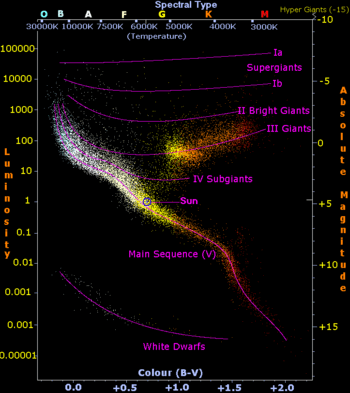
The time a star spends on the main sequence depends primarily on the amount of fuel it has and the rate at which it fuses it. The Sun is expected to live 10 billion (1010) years. Massive stars consume their fuel very rapidly and are short-lived. Low mass stars consume their fuel very slowly. Stars less massive than 0.25 M☉, called red dwarfs, are able to fuse nearly all of their mass while stars of about 1 M☉ can only fuse about 10% of their mass. The combination of their slow fuel-consumption and relatively large usable fuel supply allows low mass stars to last about one trillion (10×1012) years; the most extreme of 0.08 M☉ will last for about 12 trillion years. Red dwarfs become hotter and more luminous as they accumulate helium. When they eventually run out of hydrogen, they contract into a white dwarf and decline in temperature.[60] Since the lifespan of such stars is greater than the current age of the universe (13.8 billion years), no stars under about 0.85 M☉[81] are expected to have moved off the main sequence.
Besides mass, the elements heavier than helium can play a significant role in the evolution of stars. Astronomers label all elements heavier than helium "metals", and call the chemical concentration of these elements in a star, its metallicity. A star's metallicity can influence the time the star takes to burn its fuel, and controls the formation of its magnetic fields,[82] which affects the strength of its stellar wind.[83] Older, population II stars have substantially less metallicity than the younger, population I stars due to the composition of the molecular clouds from which they formed. Over time, such clouds become increasingly enriched in heavier elements as older stars die and shed portions of their atmospheres.[84]
Post–main sequence
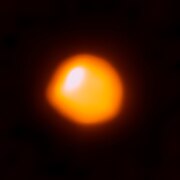
As stars of at least 0.4 M☉[85] exhaust the supply of hydrogen at their core, they start to fuse hydrogen in a shell surrounding the helium core. The outer layers of the star expand and cool greatly as they transition into a red giant. In some cases, they will fuse heavier elements at the core or in shells around the core. As the stars expand, they throw part of their mass, enriched with those heavier elements, into the interstellar environment, to be recycled later as new stars.[86] In about 5 billion years, when the Sun enters the helium burning phase, it will expand to a maximum radius of roughly 1 astronomical unit (150 million kilometres), 250 times its present size, and lose 30% of its current mass.[77][87]
As the hydrogen-burning shell produces more helium, the core increases in mass and temperature. In a red giant of up to 2.25 M☉, the mass of the helium core becomes degenerate prior to helium fusion. Finally, when the temperature increases sufficiently, core helium fusion begins explosively in what is called a helium flash, and the star rapidly shrinks in radius, increases its surface temperature, and moves to the horizontal branch of the HR diagram. For more massive stars, helium core fusion starts before the core becomes degenerate, and the star spends some time in the red clump, slowly burning helium, before the outer convective envelope collapses and the star then moves to the horizontal branch.[88]
After a star has fused the helium of its core, it begins fusing helium along a shell surrounding the hot carbon core. The star then follows an evolutionary path called the asymptotic giant branch (AGB) that parallels the other described red-giant phase, but with a higher luminosity. The more massive AGB stars may undergo a brief period of carbon fusion before the core becomes degenerate. During the AGB phase, stars undergo thermal pulses due to instabilities in the core of the star. In these thermal pulses, the luminosity of the star varies and matter is ejected from the star's atmosphere, ultimately forming a planetary nebula. As much as 50 to 70% of a star's mass can be ejected in this mass loss process. Because energy transport in an AGB star is primarily by convection, this ejected material is enriched with the fusion products dredged up from the core. Therefore, the planetary nebula is enriched with elements like carbon and oxygen. Ultimately, the planetary nebula disperses, enriching the general interstellar medium.[89] Therefore, future generations of stars are made of the "star stuff" from past stars.[90]
Massive stars

During their helium-burning phase, a star of more than 9 solar masses expands to form first a blue supergiant and then a red supergiant. Particularly massive stars (exceeding 40 solar masses, like Alnilam, the central blue supergiant of Orion's Belt)[91] do not become red supergiants due to high mass loss.[92] These may instead evolve to a Wolf–Rayet star, characterised by spectra dominated by emission lines of elements heavier than hydrogen, which have reached the surface due to strong convection and intense mass loss, or from stripping of the outer layers.[93]
When helium is exhausted at the core of a massive star, the core contracts and the temperature and pressure rises enough to fuse carbon (see Carbon-burning process). This process continues, with the successive stages being fueled by neon (see neon-burning process), oxygen (see oxygen-burning process), and silicon (see silicon-burning process). Near the end of the star's life, fusion continues along a series of onion-layer shells within a massive star. Each shell fuses a different element, with the outermost shell fusing hydrogen; the next shell fusing helium, and so forth.[94]
The final stage occurs when a massive star begins producing iron. Since iron nuclei are more tightly bound than any heavier nuclei, any fusion beyond iron does not produce a net release of energy.[95]
Some massive stars, particularly luminous blue variables, are very unstable to the extent that they violently shed their mass into space in events known as supernova impostors, becoming significantly brighter in the process. Eta Carinae is known for having underwent a supernova impostor event, the Great Eruption, in the 19th century.
Collapse
As a star's core shrinks, the intensity of radiation from that surface increases, creating such radiation pressure on the outer shell of gas that it will push those layers away, forming a planetary nebula. If what remains after the outer atmosphere has been shed is less than roughly 1.4 M☉, it shrinks to a relatively tiny object about the size of Earth, known as a white dwarf. White dwarfs lack the mass for further gravitational compression to take place.[96] The electron-degenerate matter inside a white dwarf is no longer a plasma. Eventually, white dwarfs fade into black dwarfs over a very long period of time.[97]
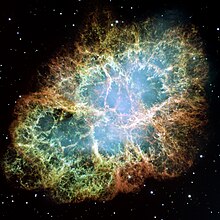
In massive stars, fusion continues until the iron core has grown so large (more than 1.4 M☉) that it can no longer support its own mass. This core will suddenly collapse as its electrons are driven into its protons, forming neutrons, neutrinos, and gamma rays in a burst of electron capture and inverse beta decay. The shockwave formed by this sudden collapse causes the rest of the star to explode in a supernova. Supernovae become so bright that they may briefly outshine the star's entire home galaxy. When they occur within the Milky Way, supernovae have historically been observed by naked-eye observers as "new stars" where none seemingly existed before.[98]
A supernova explosion blows away the star's outer layers, leaving a remnant such as the Crab Nebula.[98] The core is compressed into a neutron star, which sometimes manifests itself as a pulsar or X-ray burster. In the case of the largest stars, the remnant is a black hole greater than 4 M☉.[99] In a neutron star the matter is in a state known as neutron-degenerate matter, with a more exotic form of degenerate matter, QCD matter, possibly present in the core.[100]
The blown-off outer layers of dying stars include heavy elements, which may be recycled during the formation of new stars. These heavy elements allow the formation of rocky planets. The outflow from supernovae and the stellar wind of large stars play an important part in shaping the interstellar medium.[98]
Binary stars
Binary stars' evolution may significantly differ from that of single stars of the same mass. For example, when any star expands to become a red giant, it may overflow its Roche lobe, the surrounding region where material is gravitationally bound to it; if stars in a binary system are close enough, some of that material may overflow to the other star, yielding phenomena including contact binaries, common-envelope binaries, cataclysmic variables, blue stragglers,[101] and type Ia supernovae. Mass transfer leads to cases such as the Algol paradox, where the most-evolved star in a system is the least massive.[102]
The evolution of binary star and higher-order star systems is intensely researched since so many stars have been found to be members of binary systems. Around half of Sun-like stars, and an even higher proportion of more massive stars, form in multiple systems, and this may greatly influence such phenomena as novae and supernovae, the formation of certain types of star, and the enrichment of space with nucleosynthesis products.[103]
The influence of binary star evolution on the formation of evolved massive stars such as luminous blue variables, Wolf–Rayet stars, and the progenitors of certain classes of core collapse supernova is still disputed. Single massive stars may be unable to expel their outer layers fast enough to form the types and numbers of evolved stars that are observed, or to produce progenitors that would explode as the supernovae that are observed. Mass transfer through gravitational stripping in binary systems is seen by some astronomers as the solution to that problem.[104][105][106]
Distribution

Stars are not spread uniformly across the universe but are normally grouped into galaxies along with interstellar gas and dust. A typical large galaxy like the Milky Way contains hundreds of billions of stars. There are more than 2 trillion (1012) galaxies, though most are less than 10% the mass of the Milky Way.[107] Overall, there are likely to be between 1022 and 1024 stars[108][109] (more stars than all the grains of sand on planet Earth).[110][111][112] Most stars are within galaxies, but between 10 and 50% of the starlight in large galaxy clusters may come from stars outside of any galaxy.[113][114][115]
A multi-star system consists of two or more gravitationally bound stars that orbit each other. The simplest and most common multi-star system is a binary star, but systems of three or more stars exist. For reasons of orbital stability, such multi-star systems are often organized into hierarchical sets of binary stars.[116] Larger groups are called star clusters. These range from loose stellar associations with only a few stars to open clusters with dozens to thousands of stars, up to enormous globular clusters with hundreds of thousands of stars. Such systems orbit their host galaxy. The stars in an open or globular cluster all formed from the same giant molecular cloud, so all members normally have similar ages and compositions.[89]
Many stars are observed, and most or all may have originally formed in gravitationally bound, multiple-star systems. This is particularly true for very massive O and B class stars, 80% of which are believed to be part of multiple-star systems. The proportion of single star systems increases with decreasing star mass, so that only 25% of red dwarfs are known to have stellar companions. As 85% of all stars are red dwarfs, more than two thirds of stars in the Milky Way are likely single red dwarfs.[117] In a 2017 study of the Perseus molecular cloud, astronomers found that most of the newly formed stars are in binary systems. In the model that best explained the data, all stars initially formed as binaries, though some binaries later split up and leave single stars behind.[118][119]
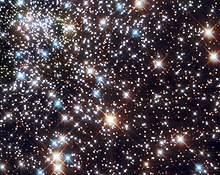
The nearest star to the Earth, apart from the Sun, is Proxima Centauri, 4.2465 light-years (40.175 trillion kilometres) away. Travelling at the orbital speed of the Space Shuttle, 8 kilometres per second (29,000 kilometres per hour), it would take about 150,000 years to arrive.[120] This is typical of stellar separations in galactic discs.[121] Stars can be much closer to each other in the centres of galaxies[122] and in globular clusters,[123] or much farther apart in galactic halos.[124]
Due to the relatively vast distances between stars outside the galactic nucleus, collisions between stars are thought to be rare. In denser regions such as the core of globular clusters or the galactic center, collisions can be more common.[125] Such collisions can produce what are known as blue stragglers. These abnormal stars have a higher surface temperature and thus are bluer than stars at the main sequence turnoff in the cluster to which they belong; in standard stellar evolution, blue stragglers would already have evolved off the main sequence and thus would not be seen in the cluster.[126]
Characteristics
Almost everything about a star is determined by its initial mass, including such characteristics as luminosity, size, evolution, lifespan, and its eventual fate.
Age
Most stars are between 1 billion and 10 billion years old. Some stars may even be close to 13.8 billion years old—the observed age of the universe. The oldest star yet discovered, HD 140283, nicknamed Methuselah star, is an estimated 14.46 ± 0.8 billion years old.[127] (Due to the uncertainty in the value, this age for the star does not conflict with the age of the universe, determined by the Planck satellite as 13.799 ± 0.021).[127][128]
The more massive the star, the shorter its lifespan, primarily because massive stars have greater pressure on their cores, causing them to burn hydrogen more rapidly. The most massive stars last an average of a few million years, while stars of minimum mass (red dwarfs) burn their fuel very slowly and can last tens to hundreds of billions of years.[129][130]
| Initial Mass (M☉) | Main Sequence | Subgiant | First Red Giant | Core He Burning |
|---|---|---|---|---|
| 1.0 | 9.33 | 2.57 | 0.76 | 0.13 |
| 1.6 | 2.28 | 0.03 | 0.12 | 0.13 |
| 2.0 | 1.20 | 0.01 | 0.02 | 0.28 |
| 5.0 | 0.10 | 0.0004 | 0.0003 | 0.02 |
Chemical composition
When stars form in the present Milky Way galaxy, they are composed of about 71% hydrogen and 27% helium,[132] as measured by mass, with a small fraction of heavier elements. Typically the portion of heavy elements is measured in terms of the iron content of the stellar atmosphere, as iron is a common element and its absorption lines are relatively easy to measure. The portion of heavier elements may be an indicator of the likelihood that the star has a planetary system.[133]
As of 2005[update] the star with the lowest iron content ever measured is the dwarf HE1327-2326, with only 1/200,000th the iron content of the Sun.[134] By contrast, the super-metal-rich star μ Leonis has nearly double the abundance of iron as the Sun, while the planet-bearing star 14 Herculis has nearly triple the iron.[135] Chemically peculiar stars show unusual abundances of certain elements in their spectrum; especially chromium and rare earth elements.[136] Stars with cooler outer atmospheres, including the Sun, can form various diatomic and polyatomic molecules.[137]

Diameter
Due to their great distance from the Earth, all stars except the Sun appear to the unaided eye as shining points in the night sky that twinkle because of the effect of the Earth's atmosphere. The Sun is close enough to the Earth to appear as a disk instead, and to provide daylight. Other than the Sun, the star with the largest apparent size is R Doradus, with an angular diameter of only 0.057 arcseconds.[138]
The disks of most stars are much too small in angular size to be observed with current ground-based optical telescopes, so interferometer telescopes are required to produce images of these objects. Another technique for measuring the angular size of stars is through occultation. By precisely measuring the drop in brightness of a star as it is occulted by the Moon (or the rise in brightness when it reappears), the star's angular diameter can be computed.[139]
Stars range in size from neutron stars, which vary anywhere from 20 to 40 km (25 mi) in diameter, to supergiants like Betelgeuse in the Orion constellation, which has a diameter about 640 times that of the Sun[140] with a much lower density.[141]
Kinematics
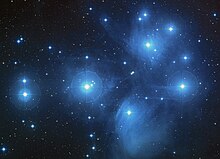
The motion of a star relative to the Sun can provide useful information about the origin and age of a star, as well as the structure and evolution of the surrounding galaxy.[143] The components of motion of a star consist of the radial velocity toward or away from the Sun, and the traverse angular movement, which is called its proper motion.[144]
Radial velocity is measured by the doppler shift of the star's spectral lines and is given in units of km/s. The proper motion of a star, its parallax, is determined by precise astrometric measurements in units of milli-arc seconds (mas) per year. With knowledge of the star's parallax and its distance, the proper motion velocity can be calculated. Together with the radial velocity, the total velocity can be calculated. Stars with high rates of proper motion are likely to be relatively close to the Sun, making them good candidates for parallax measurements.[145]
When both rates of movement are known, the space velocity of the star relative to the Sun or the galaxy can be computed. Among nearby stars, it has been found that younger population I stars have generally lower velocities than older, population II stars. The latter have elliptical orbits that are inclined to the plane of the galaxy.[146] A comparison of the kinematics of nearby stars has allowed astronomers to trace their origin to common points in giant molecular clouds; such groups with common points of origin are referred to as stellar associations.[147]
Magnetic field
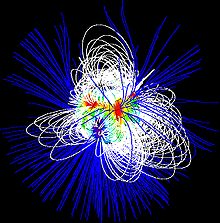
The magnetic field of a star is generated within regions of the interior where convective circulation occurs. This movement of conductive plasma functions like a dynamo, wherein the movement of electrical charges induce magnetic fields, as does a mechanical dynamo. Those magnetic fields have a great range that extend throughout and beyond the star. The strength of the magnetic field varies with the mass and composition of the star, and the amount of magnetic surface activity depends upon the star's rate of rotation. This surface activity produces starspots, which are regions of strong magnetic fields and lower than normal surface temperatures. Coronal loops are arching magnetic field flux lines that rise from a star's surface into the star's outer atmosphere, its corona. The coronal loops can be seen due to the plasma they conduct along their length. Stellar flares are bursts of high-energy particles that are emitted due to the same magnetic activity.[148]
Young, rapidly rotating stars tend to have high levels of surface activity because of their magnetic field. The magnetic field can act upon a star's stellar wind, functioning as a brake to gradually slow the rate of rotation with time. Thus, older stars such as the Sun have a much slower rate of rotation and a lower level of surface activity. The activity levels of slowly rotating stars tend to vary in a cyclical manner and can shut down altogether for periods of time.[149] During the Maunder Minimum, for example, the Sun underwent a 70-year period with almost no sunspot activity.[150]
Mass
Stars have masses ranging from less than half the solar mass to over 200 solar masses (see List of most massive stars). One of the most massive stars known is Eta Carinae,[151] which, with 100–150 times as much mass as the Sun, will have a lifespan of only several million years. Studies of the most massive open clusters suggests 150 M☉ as a rough upper limit for stars in the current era of the universe.[152] This represents an empirical value for the theoretical limit on the mass of forming stars due to increasing radiation pressure on the accreting gas cloud. Several stars in the R136 cluster in the Large Magellanic Cloud have been measured with larger masses,[153] but it has been determined that they could have been created through the collision and merger of massive stars in close binary systems, sidestepping the 150 M☉ limit on massive star formation.[154]
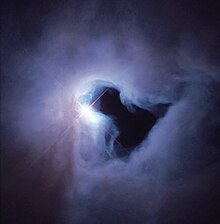
The first stars to form after the Big Bang may have been larger, up to 300 M☉,[155] due to the complete absence of elements heavier than lithium in their composition. This generation of supermassive population III stars is likely to have existed in the very early universe (i.e., they are observed to have a high redshift), and may have started the production of chemical elements heavier than hydrogen that are needed for the later formation of planets and life. In June 2015, astronomers reported evidence for Population III stars in the Cosmos Redshift 7 galaxy at z = 6.60.[156][157]
With a mass only 80 times that of Jupiter (MJ), 2MASS J0523-1403 is the smallest known star undergoing nuclear fusion in its core.[158] For stars with metallicity similar to the Sun, the theoretical minimum mass the star can have and still undergo fusion at the core, is estimated to be about 75 MJ.[159][160] When the metallicity is very low, the minimum star size seems to be about 8.3% of the solar mass, or about 87 MJ.[160][161] Smaller bodies called brown dwarfs, occupy a poorly defined grey area between stars and gas giants.[159][160]
The combination of the radius and the mass of a star determines its surface gravity. Giant stars have a much lower surface gravity than do main sequence stars, while the opposite is the case for degenerate, compact stars such as white dwarfs. The surface gravity can influence the appearance of a star's spectrum, with higher gravity causing a broadening of the absorption lines.[35]
Rotation
The rotation rate of stars can be determined through spectroscopic measurement, or more exactly determined by tracking their starspots. Young stars can have a rotation greater than 100 km/s at the equator. The B-class star Achernar, for example, has an equatorial velocity of about 225 km/s or greater, causing its equator to bulge outward and giving it an equatorial diameter that is more than 50% greater than between the poles. This rate of rotation is just below the critical velocity of 300 km/s at which speed the star would break apart.[162] By contrast, the Sun rotates once every 25–35 days depending on latitude,[163] with an equatorial velocity of 1.93 km/s.[164] A main sequence star's magnetic field and the stellar wind serve to slow its rotation by a significant amount as it evolves on the main sequence.[165]
Degenerate stars have contracted into a compact mass, resulting in a rapid rate of rotation. However they have relatively low rates of rotation compared to what would be expected by conservation of angular momentum—the tendency of a rotating body to compensate for a contraction in size by increasing its rate of spin. A large portion of the star's angular momentum is dissipated as a result of mass loss through the stellar wind.[166] In spite of this, the rate of rotation for a pulsar can be very rapid. The pulsar at the heart of the Crab nebula, for example, rotates 30 times per second.[167] The rotation rate of the pulsar will gradually slow due to the emission of radiation.[168]
Temperature
The surface temperature of a main sequence star is determined by the rate of energy production of its core and by its radius, and is often estimated from the star's color index.[169] The temperature is normally given in terms of an effective temperature, which is the temperature of an idealized black body that radiates its energy at the same luminosity per surface area as the star. The effective temperature is only representative of the surface, as the temperature increases toward the core.[170] The temperature in the core region of a star is several million kelvins.[171]
The stellar temperature will determine the rate of ionization of various elements, resulting in characteristic absorption lines in the spectrum. The surface temperature of a star, along with its visual absolute magnitude and absorption features, is used to classify a star (see classification below).[35]
Massive main sequence stars can have surface temperatures of 50,000 K. Smaller stars such as the Sun have surface temperatures of a few thousand K. Red giants have relatively low surface temperatures of about 3,600 K; but they have a high luminosity due to their large exterior surface area.[172]
Radiation
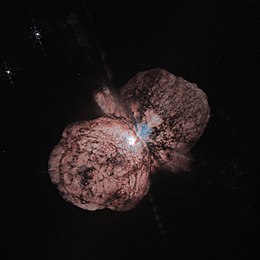
The energy produced by stars, a product of nuclear fusion, radiates to space as both electromagnetic radiation and particle radiation. The particle radiation emitted by a star is manifested as the stellar wind,[173] which streams from the outer layers as electrically charged protons and alpha and beta particles. A steady stream of almost massless neutrinos emanate directly from the star's core.[174]
The production of energy at the core is the reason stars shine so brightly: every time two or more atomic nuclei fuse together to form a single atomic nucleus of a new heavier element, gamma ray photons are released from the nuclear fusion product. This energy is converted to other forms of electromagnetic energy of lower frequency, such as visible light, by the time it reaches the star's outer layers.[175]
The color of a star, as determined by the most intense frequency of the visible light, depends on the temperature of the star's outer layers, including its photosphere.[176] Besides visible light, stars emit forms of electromagnetic radiation that are invisible to the human eye. In fact, stellar electromagnetic radiation spans the entire electromagnetic spectrum, from the longest wavelengths of radio waves through infrared, visible light, ultraviolet, to the shortest of X-rays, and gamma rays. From the standpoint of total energy emitted by a star, not all components of stellar electromagnetic radiation are significant, but all frequencies provide insight into the star's physics.[174]
Using the stellar spectrum, astronomers can determine the surface temperature, surface gravity, metallicity and rotational velocity of a star. If the distance of the star is found, such as by measuring the parallax, then the luminosity of the star can be derived. The mass, radius, surface gravity, and rotation period can then be estimated based on stellar models. (Mass can be calculated for stars in binary systems by measuring their orbital velocities and distances. Gravitational microlensing has been used to measure the mass of a single star.[177]) With these parameters, astronomers can estimate the age of the star.[178]
Luminosity
The luminosity of a star is the amount of light and other forms of radiant energy it radiates per unit of time. It has units of power. The luminosity of a star is determined by its radius and surface temperature. Many stars do not radiate uniformly across their entire surface. The rapidly rotating star Vega, for example, has a higher energy flux (power per unit area) at its poles than along its equator.[179]
Patches of the star's surface with a lower temperature and luminosity than average are known as starspots. Small, dwarf stars such as the Sun generally have essentially featureless disks with only small starspots. Giant stars have much larger, more obvious starspots,[149] and they exhibit strong stellar limb darkening. That is, the brightness decreases towards the edge of the stellar disk.[180] Red dwarf flare stars such as UV Ceti may possess prominent starspot features.[181]
Magnitude
The apparent brightness of a star is expressed in terms of its apparent magnitude. It is a function of the star's luminosity, its distance from Earth, the extinction effect of interstellar dust and gas, and the altering of the star's light as it passes through Earth's atmosphere. Intrinsic or absolute magnitude is directly related to a star's luminosity, and is the apparent magnitude a star would be if the distance between the Earth and the star were 10 parsecs (32.6 light-years).[182]
| Apparent magnitude |
Number of stars[183] |
|---|---|
| 0 | 4 |
| 1 | 15 |
| 2 | 48 |
| 3 | 171 |
| 4 | 513 |
| 5 | 1,602 |
| 6 | 4,800 |
| 7 | 14,000 |
Both the apparent and absolute magnitude scales are logarithmic units: one whole number difference in magnitude is equal to a brightness variation of about 2.5 times[184] (the 5th root of 100 or approximately 2.512). This means that a first magnitude star (+1.00) is about 2.5 times brighter than a second magnitude (+2.00) star, and about 100 times brighter than a sixth magnitude star (+6.00). The faintest stars visible to the naked eye under good seeing conditions are about magnitude +6.[185]
On both apparent and absolute magnitude scales, the smaller the magnitude number, the brighter the star; the larger the magnitude number, the fainter the star. The brightest stars, on either scale, have negative magnitude numbers. The variation in brightness (ΔL) between two stars is calculated by subtracting the magnitude number of the brighter star (mb) from the magnitude number of the fainter star (mf), then using the difference as an exponent for the base number 2.512; that is to say:
Relative to both luminosity and distance from Earth, a star's absolute magnitude (M) and apparent magnitude (m) are not equivalent;[184] for example, the bright star Sirius has an apparent magnitude of −1.44, but it has an absolute magnitude of +1.41.
The Sun has an apparent magnitude of −26.7, but its absolute magnitude is only +4.83. Sirius, the brightest star in the night sky as seen from Earth, is approximately 23 times more luminous than the Sun, while Canopus, the second brightest star in the night sky with an absolute magnitude of −5.53, is approximately 14,000 times more luminous than the Sun. Despite Canopus being vastly more luminous than Sirius, the latter star appears the brighter of the two. This is because Sirius is merely 8.6 light-years from the Earth, while Canopus is much farther away at a distance of 310 light-years.[186]
The most luminous known stars have absolute magnitudes of roughly −12, corresponding to 6 million times the luminosity of the Sun.[187] Theoretically, the least luminous stars are at the lower limit of mass at which stars are capable of supporting nuclear fusion of hydrogen in the core; stars just above this limit have been located in the NGC 6397 cluster. The faintest red dwarfs in the cluster are absolute magnitude 15, while a 17th absolute magnitude white dwarf has been discovered.[188][189]
Classification
| Class | Temperature | Sample star |
|---|---|---|
| O | 33,000 K or more | Zeta Ophiuchi |
| B | 10,500–30,000 K | Rigel |
| A | 7,500–10,000 K | Altair |
| F | 6,000–7,200 K | Procyon A |
| G | 5,500–6,000 K | Sun |
| K | 4,000–5,250 K | Epsilon Indi |
| M | 2,600–3,850 K | Proxima Centauri |
The current stellar classification system originated in the early 20th century, when stars were classified from A to Q based on the strength of the hydrogen line.[191] It was thought that the hydrogen line strength was a simple linear function of temperature. Instead, it was more complicated: it strengthened with increasing temperature, peaked near 9000 K, and then declined at greater temperatures. The classifications were since reordered by temperature, on which the modern scheme is based.[192]
Stars are given a single-letter classification according to their spectra, ranging from type O, which are very hot, to M, which are so cool that molecules may form in their atmospheres. The main classifications in order of decreasing surface temperature are: O, B, A, F, G, K, and M. A variety of rare spectral types are given special classifications. The most common of these are types L and T, which classify the coldest low-mass stars and brown dwarfs. Each letter has 10 sub-divisions, numbered from 0 to 9, in order of decreasing temperature. However, this system breaks down at extreme high temperatures as classes O0 and O1 may not exist.[193]
In addition, stars may be classified by the luminosity effects found in their spectral lines, which correspond to their spatial size and is determined by their surface gravity. These range from 0 (hypergiants) through III (giants) to V (main sequence dwarfs); some authors add VII (white dwarfs). Main sequence stars fall along a narrow, diagonal band when graphed according to their absolute magnitude and spectral type.[193] The Sun is a main sequence G2V yellow dwarf of intermediate temperature and ordinary size.[194]
There is additional nomenclature in the form of lower-case letters added to the end of the spectral type to indicate peculiar features of the spectrum. For example, an "e" can indicate the presence of emission lines; "m" represents unusually strong levels of metals, and "var" can mean variations in the spectral type.[193]
White dwarf stars have their own class that begins with the letter D. This is further sub-divided into the classes DA, DB, DC, DO, DZ, and DQ, depending on the types of prominent lines found in the spectrum. This is followed by a numerical value that indicates the temperature.[195]
Variable stars
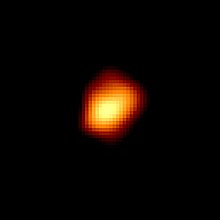
Variable stars have periodic or random changes in luminosity because of intrinsic or extrinsic properties. Of the intrinsically variable stars, the primary types can be subdivided into three principal groups.
During their stellar evolution, some stars pass through phases where they can become pulsating variables. Pulsating variable stars vary in radius and luminosity over time, expanding and contracting with periods ranging from minutes to years, depending on the size of the star. This category includes Cepheid and Cepheid-like stars, and long-period variables such as Mira.[196]
Eruptive variables are stars that experience sudden increases in luminosity because of flares or mass ejection events.[196] This group includes protostars, Wolf-Rayet stars, and flare stars, as well as giant and supergiant stars.
Cataclysmic or explosive variable stars are those that undergo a dramatic change in their properties. This group includes novae and supernovae. A binary star system that includes a nearby white dwarf can produce certain types of these spectacular stellar explosions, including the nova and a Type 1a supernova.[88] The explosion is created when the white dwarf accretes hydrogen from the companion star, building up mass until the hydrogen undergoes fusion.[197] Some novae are recurrent, having periodic outbursts of moderate amplitude.[196]
Stars can vary in luminosity because of extrinsic factors, such as eclipsing binaries, as well as rotating stars that produce extreme starspots.[196] A notable example of an eclipsing binary is Algol, which regularly varies in magnitude from 2.1 to 3.4 over a period of 2.87 days.[198]
Structure

The interior of a stable star is in a state of hydrostatic equilibrium: the forces on any small volume almost exactly counterbalance each other. The balanced forces are inward gravitational force and an outward force due to the pressure gradient within the star. The pressure gradient is established by the temperature gradient of the plasma; the outer part of the star is cooler than the core. The temperature at the core of a main sequence or giant star is at least on the order of 107 K. The resulting temperature and pressure at the hydrogen-burning core of a main sequence star are sufficient for nuclear fusion to occur and for sufficient energy to be produced to prevent further collapse of the star.[199][200]
As atomic nuclei are fused in the core, they emit energy in the form of gamma rays. These photons interact with the surrounding plasma, adding to the thermal energy at the core. Stars on the main sequence convert hydrogen into helium, creating a slowly but steadily increasing proportion of helium in the core. Eventually the helium content becomes predominant, and energy production ceases at the core. Instead, for stars of more than 0.4 M☉, fusion occurs in a slowly expanding shell around the degenerate helium core.[201]
In addition to hydrostatic equilibrium, the interior of a stable star will maintain an energy balance of thermal equilibrium. There is a radial temperature gradient throughout the interior that results in a flux of energy flowing toward the exterior. The outgoing flux of energy leaving any layer within the star will exactly match the incoming flux from below.[202]
The radiation zone is the region of the stellar interior where the flux of energy outward is dependent on radiative heat transfer, since convective heat transfer is inefficient in that zone. In this region the plasma will not be perturbed, and any mass motions will die out. Where this is not the case, then the plasma becomes unstable and convection will occur, forming a convection zone. This can occur, for example, in regions where very high energy fluxes occur, such as near the core or in areas with high opacity (making radiatative heat transfer inefficient) as in the outer envelope.[200]
The occurrence of convection in the outer envelope of a main sequence star depends on the star's mass. Stars with several times the mass of the Sun have a convection zone deep within the interior and a radiative zone in the outer layers. Smaller stars such as the Sun are just the opposite, with the convective zone located in the outer layers.[203] Red dwarf stars with less than 0.4 M☉ are convective throughout, which prevents the accumulation of a helium core.[85] For most stars the convective zones will vary over time as the star ages and the constitution of the interior is modified.[200]
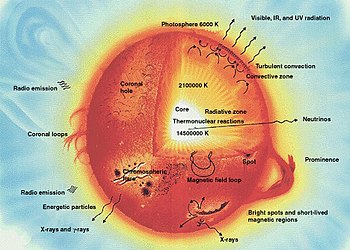
The photosphere is that portion of a star that is visible to an observer. This is the layer at which the plasma of the star becomes transparent to photons of light. From here, the energy generated at the core becomes free to propagate into space. It is within the photosphere that sun spots, regions of lower than average temperature, appear.[204]
Above the level of the photosphere is the stellar atmosphere. In a main sequence star such as the Sun, the lowest level of the atmosphere, just above the photosphere, is the thin chromosphere region, where spicules appear and stellar flares begin. Above this is the transition region, where the temperature rapidly increases within a distance of only 100 km (62 mi). Beyond this is the corona, a volume of super-heated plasma that can extend outward to several million kilometres.[205] The existence of a corona appears to be dependent on a convective zone in the outer layers of the star.[203] Despite its high temperature, the corona emits very little light, due to its low gas density.[206] The corona region of the Sun is normally only visible during a solar eclipse.
From the corona, a stellar wind of plasma particles expands outward from the star, until it interacts with the interstellar medium. For the Sun, the influence of its solar wind extends throughout a bubble-shaped region called the heliosphere.[207]
Nuclear fusion reaction pathways
When nuclei fuse, the mass of the fused product is less than the mass of the original parts. This lost mass is converted to electromagnetic energy, according to the mass–energy equivalence relationship .[208] A variety of nuclear fusion reactions take place in the cores of stars, that depend upon their mass and composition.
The hydrogen fusion process is temperature-sensitive, so a moderate increase in the core temperature will result in a significant increase in the fusion rate. As a result, the core temperature of main sequence stars only varies from 4 million kelvin for a small M-class star to 40 million kelvin for a massive O-class star.[171]
In the Sun, with a 16-million-kelvin core, hydrogen fuses to form helium in the proton–proton chain reaction:[209]
- 41H → 22H + 2e+ + 2νe(2 x 0.4 MeV)
- 2e+ + 2e− → 2γ (2 x 1.0 MeV)
- 21H + 22H → 23He + 2γ (2 x 5.5 MeV)
- 23He → 4He + 21H (12.9 MeV)
There are a couple other paths, in which 3He and 4He combine to form 7Be, which eventually (with the addition of another proton) yields two 4He, a gain of one.
All these reactions result in the overall reaction:
- 41H → 4He + 2γ + 2νe (26.7 MeV)
where γ is a gamma ray photon, νe is a neutrino, and H and He are isotopes of hydrogen and helium, respectively. The energy released by this reaction is in millions of electron volts. Each individual reaction produces only a tiny amount of energy, but because enormous numbers of these reactions occur constantly, they produce all the energy necessary to sustain the star's radiation output. In comparison, the combustion of two hydrogen gas molecules with one oxygen gas molecule releases only 5.7 eV.
In more massive stars, helium is produced in a cycle of reactions catalyzed by carbon called the carbon-nitrogen-oxygen cycle.[209]
In evolved stars with cores at 100 million kelvin and masses between 0.5 and 10 M☉, helium can be transformed into carbon in the triple-alpha process that uses the intermediate element beryllium:[209]
For an overall reaction of:

- 34He → 12C + γ + 7.2 MeV
In massive stars, heavier elements can be burned in a contracting core through the neon-burning process and oxygen-burning process. The final stage in the stellar nucleosynthesis process is the silicon-burning process that results in the production of the stable isotope iron-56.[209] Any further fusion would be an endothermic process that consumes energy, and so further energy can only be produced through gravitational collapse.
| Fuel material |
Temperature (million kelvins) |
Density (kg/cm3) |
Burn duration (τ in years) |
|---|---|---|---|
| H | 37 | 0.0045 | 8.1 million |
| He | 188 | 0.97 | 1.2 million |
| C | 870 | 170 | 976 |
| Ne | 1,570 | 3,100 | 0.6 |
| O | 1,980 | 5,550 | 1.25 |
| S/Si | 3,340 | 33,400 | 0.0315 (~11.5 days) |
See also
- List of proper names of stars
- Outline of astronomy
- Sidereal time
- Star clocks
- Star count
- Stars in fiction
References
- ^ Temming, Maria (15 July 2014). "What is a star?". AAS Sky Publishing, LLC. Retrieved 22 April 2024.
- ^ Grego, Peter; Mannion, David (2010). Galileo and 400 Years of Telescopic Astronomy. Springer New York. ISBN 978-1441955920.
- ^ Harper, Douglas (2001–2022). "*ster- (2)". Online Etymology Dictionary. Retrieved 28 February 2022.
- ^ a b Forbes, George (1909). History of Astronomy. London: Watts & Co. ISBN 978-1-153-62774-0.
- ^ Hevelius, Johannis (1690). Firmamentum Sobiescianum, sive Uranographia. Gdansk.
- ^ "Ancient Greek Astronomy and Cosmology". Digital Collections. The Library of Congress. n.d. Retrieved 28 February 2022.
- ^ Tøndering, Claus (2008). "Other Ancient Calendars". Calendars Through The Ages. Webexhibits. Retrieved 28 February 2022.
- ^ von Spaeth, Ove (2000). "Dating the Oldest Egyptian Star Map". Centaurus. 42 (3): 159–179. Bibcode:2000Cent...42..159V. doi:10.1034/j.1600-0498.2000.420301.x. Retrieved 21 October 2007.
- ^ North, John (1995). The Norton History of Astronomy and Cosmology. New York and London: W.W. Norton & Company. pp. 30–31. ISBN 978-0-393-03656-5.
- ^ Murdin, P. (2000). "Aristillus (c. 200 BC)". Encyclopedia of Astronomy and Astrophysics. Bibcode:2000eaa..bookE3440.. doi:10.1888/0333750888/3440. ISBN 978-0-333-75088-9.
- ^ Grasshoff, Gerd (1990). The history of Ptolemy's star catalogue. Springer. pp. 1–5. ISBN 978-0-387-97181-0.
- ^ Pinotsis, Antonios D. (2008). "Astronomy in Ancient Rhodes". Protostellar Jets In Context. University of Athens, Greece. Archived from the original on 7 September 2021. Retrieved 28 February 2022.
- ^ Clark, D. H.; Stephenson, F. R. (29 June 1981). "The Historical Supernovae". Supernovae: A survey of current research; Proceedings of the Advanced Study Institute. Advanced Study Institute. Cambridge, UK: Dordrecht, D. Reidel Publishing Company. pp. 355–370. Bibcode:1982ASIC...90..355C.
- ^ Zhao, Fu-Yuan; Strom, R. G.; Jiang, Shi-Yang (2006). "The Guest Star of AD185 must have been a Supernova". Chinese Journal of Astronomy and Astrophysics. 6 (5): 635. Bibcode:2006ChJAA...6..635Z. doi:10.1088/1009-9271/6/5/17.
- ^ Isbell, Douglas; Benoit, Phil (5 March 2003). "Astronomers Peg Brightness of History's Brightest Star". NOIRLab. National Optical Astronomy Observatory. Archived from the original on 2 April 2003. Retrieved 28 February 2022.
- ^ Frommert, Hartmut; Kronberg, Christine (30 August 2006). "Supernova 1054 – Creation of the Crab Nebula". SEDS. University of Arizona.
- ^ Duyvendak, J. J. L. (April 1942). "Further Data Bearing on the Identification of the Crab Nebula with the Supernova of 1054 A.D. Part I. The Ancient Oriental Chronicles". Publications of the Astronomical Society of the Pacific. 54 (318): 91–94. Bibcode:1942PASP...54...91D. doi:10.1086/125409.
Mayall, N. U.; Oort, Jan Hendrik (April 1942). "Further Data Bearing on the Identification of the Crab Nebula with the Supernova of 1054 A.D. Part II. The Astronomical Aspects". Publications of the Astronomical Society of the Pacific. 54 (318): 95–104. Bibcode:1942PASP...54...95M. doi:10.1086/125410. - ^ Brecher, K.; et al. (1983). "Ancient records and the Crab Nebula supernova". The Observatory. 103: 106–113. Bibcode:1983Obs...103..106B.
- ^ Kennedy, Edward S. (1962). "Review: The Observatory in Islam and Its Place in the General History of the Observatory by Aydin Sayili". Isis. 53 (2): 237–239. doi:10.1086/349558.
- ^ Jones, Kenneth Glyn (1991). Messier's nebulae and star clusters. Cambridge University Press. p. 1. ISBN 978-0-521-37079-0.
- ^ Zahoor, A. (1997). "Al-Biruni". Hasanuddin University. Archived from the original on 26 June 2008. Retrieved 21 October 2007.
- ^ Montada, Josep Puig (28 September 2007). "Ibn Bajja". Stanford Encyclopedia of Philosophy. Retrieved 11 July 2008.
- ^ a b c Drake, Stephen A. (17 August 2006). "A Brief History of High-Energy (X-ray & Gamma-Ray) Astronomy". NASA HEASARC. Retrieved 24 August 2006.
- ^ Greskovic, Peter; Rudy, Peter (24 July 2006). "Exoplanets". ESO. Archived from the original on 10 October 2008. Retrieved 15 June 2012.
- ^ Ahmad, I. A. (1995). "The impact of the Qur'anic conception of astronomical phenomena on Islamic civilization". Vistas in Astronomy. 39 (4): 395–403 [402]. Bibcode:1995VA.....39..395A. doi:10.1016/0083-6656(95)00033-X.
- ^ Setia, Adi (2004). "Fakhr Al-Din Al-Razi on Physics and the Nature of the Physical World: A Preliminary Survey" (PDF). Islam & Science. 2 (2). Archived from the original (PDF) on 9 January 2020. Retrieved 26 May 2018.
- ^ Hoskin, Michael (1998). "The Value of Archives in Writing the History of Astronomy". Library and Information Services in Astronomy III. 153: 207. Bibcode:1998ASPC..153..207H. Retrieved 24 August 2006.
- ^ Proctor, Richard A. (1870). "Are any of the nebulæ star-systems?". Nature. 1 (13): 331–333. Bibcode:1870Natur...1..331P. doi:10.1038/001331a0.
- ^ Magill, Frank Northen (1992). Magill's Survey of Science: A-Cherenkov detectors. Salem Press. p. 219. ISBN 978-0-89356-619-7.
- ^ MacDonnell, Joseph. "Angelo Secchi, S.J. (1818–1878) the Father of Astrophysics". Fairfield University. Archived from the original on 21 July 2011. Retrieved 2 October 2006.
- ^ Hubeny, Ivan; Mihalas, Dimitri (2014). Theory of Stellar Atmospheres: An Introduction to Astrophysical Non-equilibrium Quantitative Spectroscopic Analysis. Princeton University Press. p. 23. ISBN 978-0-691-16329-1.
- ^ Aitken, Robert G. (1964). The Binary Stars. New York: Dover Publications Inc. p. 66. ISBN 978-0-486-61102-0.
- ^ Michelson, A. A.; Pease, F. G. (1921). "Measurement of the diameter of Alpha Orionis with the interferometer". Astrophysical Journal. 53 (5): 249–259. Bibcode:1921ApJ....53..249M. doi:10.1086/142603. PMC 1084808. PMID 16586823. S2CID 21969744.
- ^ "" Payne-Gaposchkin, Cecilia Helena." CWP". University of California. Archived from the original on 18 March 2005. Retrieved 21 February 2013.
- ^ a b c Unsöld, Albrecht (2001). The New Cosmos (5th ed.). New York: Springer. pp. 180–185, 215–216. ISBN 978-3-540-67877-9.
- ^ Gordon, Michael S.; Humphreys, Roberta M.; Jones, Terry J. (July 2016). "Luminous and Variable Stars in M31 and M33. III. The Yellow and Red Supergiants and Post-red Supergiant Evolution". The Astrophysical Journal. 825 (1): 50. arXiv:1603.08003. Bibcode:2016ApJ...825...50G. doi:10.3847/0004-637X/825/1/50. ISSN 0004-637X. S2CID 119281102.
- ^ Brown, A. G. A.; et al. (Gaia collaboration) (2021). "Gaia Early Data Release 3: Summary of the contents and survey properties". Astronomy & Astrophysics. 649: A1. arXiv:2012.01533. Bibcode:2021A&A...649A...1G. doi:10.1051/0004-6361/202039657. S2CID 227254300. (Erratum: doi:10.1051/0004-6361/202039657e).
- ^ De Grijs, Richard; Bono, Giuseppe (2020). "Clustering of Local Group Distances: Publication Bias or Correlated Measurements? VI. Extending to Virgo Cluster Distances". The Astrophysical Journal Supplement Series. 246 (1): 3. arXiv:1911.04312. Bibcode:2020ApJS..246....3D. doi:10.3847/1538-4365/ab5711. S2CID 207852888.
- ^ Villard, Ray; Freedman, Wendy L. (26 October 1994). "Hubble Space Telescope Measures Precise Distance to the Most Remote Galaxy Yet". Hubble Site. Retrieved 5 August 2007.
- ^ Solovyeva, Y.; Vinokurov, A.; Sarkisyan, A.; Atapin, K.; Fabrika, S.; Valeev, A. F.; Kniazev, A.; Sholukhova, O.; Maslennikova, O. (2020). "New luminous blue variable candidates in the NGC 247 galaxy". Monthly Notices of the Royal Astronomical Society. 497 (4): 4834. arXiv:2008.06215. Bibcode:2020MNRAS.497.4834S. doi:10.1093/mnras/staa2117. S2CID 221451751.
- ^ Kelly, Patrick L.; et al. (2 April 2018). "Extreme magnification of an individual star at redshift 1.5 by a galaxy-cluster lens". Nature. 2 (4): 334–342. arXiv:1706.10279. Bibcode:2018NatAs...2..334K. doi:10.1038/s41550-018-0430-3. S2CID 125826925.
- ^ Howell, Elizabeth (2 April 2018). "Rare Cosmic Alignment Reveals Most Distant Star Ever Seen". Space.com. Retrieved 2 April 2018.
- ^ Koch-Westenholz, Ulla; Koch, Ulla Susanne (1995). Mesopotamian astrology: an introduction to Babylonian and Assyrian celestial divination. Carsten Niebuhr Institute Publications. Vol. 19. Museum Tusculanum Press. p. 163. ISBN 978-87-7289-287-0.
- ^ a b Coleman, Leslie S. "Myths, Legends and Lore". Frosty Drew Observatory. Retrieved 15 June 2012.
- ^ "Naming Astronomical Objects". International Astronomical Union (IAU). Retrieved 30 January 2009.
- ^ "Naming Stars". Students for the Exploration and Development of Space (SEDS). Retrieved 30 January 2009.
- ^ Lyall, Francis; Larsen, Paul B. (2009). "Chapter 7: The Moon and Other Celestial Bodies". Space Law: A Treatise. Ashgate Publishing, Ltd. p. 176. ISBN 978-0-7546-4390-6.
- ^ "IAU Working Group on Star Names (WGSN)". Retrieved 22 May 2016.
- ^ "Naming Stars". Retrieved 5 February 2021.
- ^ Andersen, Johannes. "Buying Stars and Star Names". International Astronomical Union. Retrieved 24 June 2010.
- ^ "Star naming". Scientia Astrophysical Organization. 2005. Archived from the original on 17 June 2010. Retrieved 29 June 2010.
- ^ "Disclaimer: Name a star, name a rose and other, similar enterprises". British Library. The British Library Board. Archived from the original on 19 January 2010. Retrieved 29 June 2010.
- ^ Plait, Philip C. (2002). Bad astronomy: misconceptions and misuses revealed, from astrology to the moon landing "hoax". John Wiley and Sons. pp. 237–240. ISBN 978-0-471-40976-2.
- ^ Sclafani, Tom (8 May 1998). "Consumer Affairs Commissioner Polonetsky Warns Consumers: "Buying A Star Won't Make You One"". National Astronomy and Ionosphere Center, Aricebo Observatory. Archived from the original on 11 January 2006. Retrieved 24 June 2010.
- ^ a b c d Prsa, A.; Harmanec, P.; Torres, G.; Mamajek, E.; et al. (2016). "Nominal values for selected solar and planetary quantities: IAU 2015 Resolution B3". Astronomical Journal. 152 (2): 41. arXiv:1605.09788. Bibcode:2016AJ....152...41P. doi:10.3847/0004-6256/152/2/41. S2CID 55319250.
- ^ Woodward, P. R. (1978). "Theoretical models of star formation". Annual Review of Astronomy and Astrophysics. 16 (1): 555–584. Bibcode:1978ARA&A..16..555W. doi:10.1146/annurev.aa.16.090178.003011.
- ^ Lada, C. J.; Lada, E. A. (2003). "Embedded Clusters in Molecular Clouds". Annual Review of Astronomy and Astrophysics. 41 (1): 57–115. arXiv:astro-ph/0301540. Bibcode:2003ARA&A..41...57L. doi:10.1146/annurev.astro.41.011802.094844. S2CID 16752089.
- ^ Murray, Norman (2011). "Star Formation Efficiencies and Lifetimes of Giant Molecular Clouds in the Milky Way". The Astrophysical Journal. 729 (2): 133. arXiv:1007.3270. Bibcode:2011ApJ...729..133M. doi:10.1088/0004-637X/729/2/133. S2CID 118627665.
- ^ Kwok, Sun (2000). The origin and evolution of planetary nebulae. Cambridge astrophysics series. Vol. 33. Cambridge University Press. pp. 103–104. ISBN 978-0-521-62313-1.
- ^ a b Adams, Fred C.; Laughlin, Gregory; Graves, Genevieve J. M. "Red Dwarfs and the End of the Main Sequence" (PDF). Gravitational Collapse: From Massive Stars to Planets. Revista Mexicana de Astronomía y Astrofísica. pp. 46–49. Bibcode:2004RMxAC..22...46A. Archived from the original (PDF) on 11 July 2019. Retrieved 24 June 2008.
- ^ a b c Kolb, Vera M., ed. (2014). Astrobiology, An Evolutionary Approach. Taylor & Francis. pp. 21–25. ISBN 978-1466584617.
- ^ a b Bisnovatyi-Kogan, G. S. (2013). Stellar Physics: Stellar Evolution and Stability. Translated by Blinov, A. Y.; Romanova, M. Springer Berlin Heidelberg. pp. 108–125. ISBN 978-3662226391.
- ^ Ibeling, Duligur; Heger, Alexander (March 2013). "The Metallicity Dependence of the Minimum Mass for Core-collapse Supernovae". The Astrophysical Journal Letters. 765 (2): 4. arXiv:1301.5783. Bibcode:2013ApJ...765L..43I. doi:10.1088/2041-8205/765/2/L43. S2CID 118474569. L43.
- ^ Thielemann, F. -K.; et al. (2011). "Massive Stars and their Supernovae". In Diehl, Roland; et al. (eds.). Astronomy with Radioactivities. Lecture Notes in Physics. Vol. 812. Berlin: Springer. pp. 153–232. arXiv:1008.2144. Bibcode:2011LNP...812..153T. doi:10.1007/978-3-642-12698-7_4. ISBN 978-3-642-12697-0. S2CID 119254840.
- ^ Elmegreen, B. G.; Lada, C. J. (1977). "Sequential formation of subgroups in OB associations". Astrophysical Journal, Part 1. 214: 725–741. Bibcode:1977ApJ...214..725E. doi:10.1086/155302.
- ^ Getman, K. V.; et al. (2012). "The Elephant Trunk Nebula and the Trumpler 37 cluster: contribution of triggered star formation to the total population of an H II region". Monthly Notices of the Royal Astronomical Society. 426 (4): 2917–2943. arXiv:1208.1471. Bibcode:2012MNRAS.426.2917G. doi:10.1111/j.1365-2966.2012.21879.x. S2CID 49528100.
- ^ Smith, Michael David (2004). The Origin of Stars. Imperial College Press. pp. 57–68. ISBN 978-1-86094-501-4.
- ^ Seligman, Courtney. "Slow Contraction of Protostellar Cloud". Self-published. Archived from the original on 23 June 2008. Retrieved 5 September 2006.
- ^ Hanslmeier, Arnold (2010). Water in the Universe. Springer Science & Business Media. p. 163. ISBN 978-90-481-9984-6.
- ^ Bally, J.; Morse, J.; Reipurth, B. (1996). "The Birth of Stars: Herbig-Haro Jets, Accretion and Proto-Planetary Disks". In Benvenuti, Piero; Macchetto, F. D.; Schreier, Ethan J. (eds.). Science with the Hubble Space Telescope – II. Proceedings of a workshop held in Paris, France, December 4–8, 1995. Space Science Institute Workshop, Paris, France, December 4–8, 1995. Space Telescope Science Institute. p. 491. Bibcode:1996swhs.conf..491B.
- ^ Smith, Michael David (2004). The origin of stars. Imperial College Press. p. 176. ISBN 978-1-86094-501-4.
- ^ Megeath, Tom (11 May 2010). "Herschel finds a hole in space". ESA. Retrieved 17 May 2010.
- ^ Darling, David (2004). The Universal Book of Astronomy: From the Andromeda Galaxy to the Zone of Avoidance. Wiley. p. 229. ISBN 978-0-471-26569-6.
- ^ Duquennoy, A.; Mayor, M. (1991). "Multiplicity among solar-type stars in the solar neighbourhood. II – Distribution of the orbital elements in an unbiased sample". Astronomy & Astrophysics. 248 (2): 485–524. Bibcode:1991A&A...248..485D.
- ^ Padmanabhan, T. (2000). Theoretical Astrophysics: Volume 2, Stars and Stellar Systems. Cambridge University Press. p. 557. ISBN 978-0-521-56631-5.
- ^ Mengel, J. G.; et al. (1979). "Stellar evolution from the zero-age main sequence". Astrophysical Journal Supplement Series. 40: 733–791. Bibcode:1979ApJS...40..733M. doi:10.1086/190603.
- ^ a b Sackmann, I. J.; Boothroyd, A. I.; Kraemer, K. E. (1993). "Our Sun. III. Present and Future". Astrophysical Journal. 418: 457. Bibcode:1993ApJ...418..457S. doi:10.1086/173407.
- ^ Wood, B. E.; et al. (2002). "Measured Mass-Loss Rates of Solar-like Stars as a Function of Age and Activity". The Astrophysical Journal. 574 (1): 412–425. arXiv:astro-ph/0203437. Bibcode:2002ApJ...574..412W. doi:10.1086/340797. S2CID 1500425.
- ^ de Loore, C.; de Greve, J. P.; Lamers, H. J. G. L. M. (1977). "Evolution of massive stars with mass loss by stellar wind". Astronomy and Astrophysics. 61 (2): 251–259. Bibcode:1977A&A....61..251D.
- ^ "The evolution of stars between 50 and 100 times the mass of the Sun". England: Royal Greenwich Observatory. Archived from the original on 18 November 2015. Retrieved 17 November 2015.
- ^ "Main Sequence Lifetime". Swinburne Astronomy Online Encyclopedia of Astronomy. Swinburne University of Technology.
- ^ Pizzolato, N.; et al. (2001). "Subphotospheric convection and magnetic activity dependence on metallicity and age: Models and tests". Astronomy & Astrophysics. 373 (2): 597–607. Bibcode:2001A&A...373..597P. doi:10.1051/0004-6361:20010626.
- ^ "Mass loss and Evolution". UCL Astrophysics Group. 18 June 2004. Archived from the original on 22 November 2004. Retrieved 26 August 2006.
- ^ Rutherford Appleton Laboratory. Workshop on Astronomy and Astrophysics (1984). Gas in the Interstellar Medium: Rutherford Appleton Laboratory Workshop on Astronomy and Astrophysics : 21–23 May, 1983, The Cosener's House, Abingdon. Science and Engineering Research Council, Rutherford Appleton Laboratory.
- ^ a b Richmond, Michael. "Late stages of evolution for low-mass stars". Rochester Institute of Technology. Retrieved 4 August 2006.
- ^ "Stellar Evolution & Death". NASA Observatorium. Archived from the original on 10 February 2008. Retrieved 8 June 2006.
- ^ Schröder, K.-P.; Smith, Robert Connon (2008). "Distant future of the Sun and Earth revisited". Monthly Notices of the Royal Astronomical Society. 386 (1): 155–163. arXiv:0801.4031. Bibcode:2008MNRAS.386..155S. doi:10.1111/j.1365-2966.2008.13022.x. S2CID 10073988. See also Palmer, Jason (22 February 2008). "Hope dims that Earth will survive Sun's death". NewScientist.com news service. Retrieved 24 March 2008.
- ^ a b Iben, Icko Jr. (1991). "Single and binary star evolution". Astrophysical Journal Supplement Series. 76: 55–114. Bibcode:1991ApJS...76...55I. doi:10.1086/191565.
- ^ a b Carroll, Bradley W.; Ostlie, Dale A. (7 September 2017). "Chapter 13". An Introduction to Modern Astrophysics (2nd ed.). Cambridge, United Kingdom: Cambridge University Press. ISBN 978-1108422161.
- ^ Sagan, Carl (1980). "The Lives of the Stars". Cosmos: A Personal Voyage.
- ^ Puebla, Raul E.; Hillier, D. John; Zsargó, Janos; Cohen, David H.; Leutenegger, Maurice A. (1 March 2016). "X-ray, UV and optical analysis of supergiants: $\epsilon$ Ori". Monthly Notices of the Royal Astronomical Society. 456 (3): 2907–2936. arXiv:1511.09365. doi:10.1093/mnras/stv2783. ISSN 0035-8711.
- ^ Vanbeveren, D.; De Loore, C.; Van Rensbergen, W. (1 December 1998). "Massive stars". The Astronomy and Astrophysics Review. 9 (1): 63–152. Bibcode:1998A&ARv...9...63V. doi:10.1007/s001590050015. ISSN 1432-0754.
- ^ Conti, P. S.; de Loore, C. (2012). Mass Loss and Evolution of O-Type Stars. Springer Science & Business Media. ISBN 978-94-009-9452-2.
- ^ "The Evolution of Massive Stars and Type II Supernovae". Penn Stats College of Science. Retrieved 5 January 2016.
- ^ Sneden, Christopher (8 February 2001). "Astronomy: The age of the Universe". Nature. 409 (6821): 673–675. doi:10.1038/35055646. PMID 11217843. S2CID 4316598.
- ^ Liebert, James (1980). "White dwarf stars". Annual Review of Astronomy and Astrophysics. 18 (2): 363–398. Bibcode:1980ARA&A..18..363L. doi:10.1146/annurev.aa.18.090180.002051.
- ^ Mann, Adam (11 August 2020). "This is the way the universe ends: not with a whimper, but a bang". Science | AAAS.
- ^ a b c "Introduction to Supernova Remnants". Goddard Space Flight Center. 6 April 2006. Retrieved 16 July 2006.
- ^ Fryer, C. L. (2003). "Black-hole formation from stellar collapse". Classical and Quantum Gravity. 20 (10): S73 – S80. Bibcode:2003CQGra..20S..73F. doi:10.1088/0264-9381/20/10/309. S2CID 122297043.
- ^ Vuorinen, Aleksi (2019). "Neutron stars and stellar mergers as a laboratory for dense QCD matter". Nuclear Physics A. 982: 36. arXiv:1807.04480. Bibcode:2019NuPhA.982...36V. doi:10.1016/j.nuclphysa.2018.10.011. S2CID 56422826.
- ^ Leiner, Emily M.; Geller, Aaron (1 January 2021). "A Census of Blue Stragglers in Gaia DR2 Open Clusters as a Test of Population Synthesis and Mass Transfer Physics". The Astrophysical Journal. 908 (2): arXiv:2101.11047. arXiv:2101.11047. Bibcode:2021ApJ...908..229L. doi:10.3847/1538-4357/abd7e9. S2CID 231718656.
- ^ Brogaard, K.; Christiansen, S. M.; Grundahl, F.; Miglio, A.; Izzard, R. G.; Tauris, T. M.; Sandquist, E. L.; VandenBerg, D. A.; Jessen-Hansen, J.; Arentoft, T.; Bruntt, H.; Frandsen, S.; Orosz, J. A.; Feiden, G. A.; Mathieu, R.; Geller, A.; Shetrone, M.; Ryde, N.; Stello, D.; Platais, I.; Meibom, S. (21 December 2018). "The blue straggler V106 in NGC 6791: a prototype progenitor of old single giants masquerading as young". Monthly Notices of the Royal Astronomical Society. 481 (4): 5062–5072. arXiv:1809.00705. Bibcode:2018MNRAS.481.5062B. doi:10.1093/mnras/sty2504.
- ^ Beccari, Giacomo; Boffin, Henri M. J. (2019). The Impact of Binary Stars on Stellar Evolution. Cambridge University Press. ISBN 978-1-108-42858-3.
- ^ Yoon, Sung-Chul; Dessart, Luc; Clocchiatti, Alejandro (2017). "Type Ib and IIb Supernova Progenitors in Interacting Binary Systems". The Astrophysical Journal. 840 (1): 10. arXiv:1701.02089. Bibcode:2017ApJ...840...10Y. doi:10.3847/1538-4357/aa6afe. S2CID 119058919.
- ^ McClelland, L. A. S.; Eldridge, J. J. (2016). "Helium stars: Towards an understanding of Wolf-Rayet evolution". Monthly Notices of the Royal Astronomical Society. 459 (2): 1505. arXiv:1602.06358. Bibcode:2016MNRAS.459.1505M. doi:10.1093/mnras/stw618. S2CID 119105982.
- ^ Shenar, T.; Gilkis, A.; Vink, J. S.; Sana, H.; Sander, A. A. C. (2020). "Why binary interaction does not necessarily dominate the formation of Wolf-Rayet stars at low metallicity". Astronomy and Astrophysics. 634: A79. arXiv:2001.04476. Bibcode:2020A&A...634A..79S. doi:10.1051/0004-6361/201936948. S2CID 210472736.
- ^ Fountain, Henry (17 October 2016). "Two Trillion Galaxies, at the Very Least". The New York Times. Retrieved 17 October 2016.
- ^ Staff (2019). "How Many Stars Are There In The Universe?". European Space Agency. Retrieved 21 September 2019.
- ^ Marov, Mikhail Ya. (2015). "The Structure of the Universe". The Fundamentals of Modern Astrophysics. pp. 279–294. doi:10.1007/978-1-4614-8730-2_10. ISBN 978-1-4614-8729-6.
- ^ Mackie, Glen (1 February 2002). "To see the Universe in a Grain of Taranaki Sand". Centre for Astrophysics and Supercomputing. Retrieved 28 January 2017.
- ^ Borenstein, Seth (1 December 2010). "Universe's Star Count Could Triple". Associated Press. Retrieved 9 February 2021.
- ^ Van Dokkum, Pieter G.; Conroy, Charlie (2010). "A substantial population of low-mass stars in luminous elliptical galaxies". Nature. 468 (7326): 940–942. arXiv:1009.5992. Bibcode:2010Natur.468..940V. doi:10.1038/nature09578. PMID 21124316. S2CID 205222998.
- ^ "Hubble Finds Intergalactic Stars". Hubble News Desk. 14 January 1997. Retrieved 6 November 2006.
- ^ Puchwein, Ewald; Springel, Volker; Sijacki, Debora; Dolag, Klaus (1 August 2010). "Intracluster stars in simulations with active galactic nucleus feedback". Monthly Notices of the Royal Astronomical Society. 406 (2): 936–951. arXiv:1001.3018. Bibcode:2010MNRAS.406..936P. doi:10.1111/j.1365-2966.2010.16786.x.
- ^ Lin, Yen-Ting; Mohr, Joseph J. (20 December 2004). "K-band Properties of Galaxy Clusters and Groups: Brightest Cluster Galaxies and Intracluster Light". The Astrophysical Journal. 617 (2): 879–895. arXiv:astro-ph/0408557. Bibcode:2004ApJ...617..879L. doi:10.1086/425412. S2CID 119347770.
- ^ Szebehely, Victor G.; Curran, Richard B. (1985). Stability of the Solar System and Its Minor Natural and Artificial Bodies. Springer. ISBN 978-90-277-2046-7.
- ^ "Most Milky Way Stars Are Single" (Press release). Harvard-Smithsonian Center for Astrophysics. 30 January 2006. Retrieved 16 July 2006.
- ^ Sanders, Robert (13 June 2017). "New evidence that all stars are born in pairs". Berkeley News.
- ^ Sadavoy, Sarah I.; Stahler, Steven W. (August 2017). "Embedded binaries and their dense cores". Monthly Notices of the Royal Astronomical Society. 469 (4): 3881–3900. arXiv:1705.00049. Bibcode:2017MNRAS.469.3881S. doi:10.1093/mnras/stx1061.
- ^ 3.99×1013 km / (3×104 km/h × 24 × 365.25) = 1.5×105 years.
- ^ Holmberg, J.; Flynn, C. (2000). "The local density of matter mapped by Hipparcos". Monthly Notices of the Royal Astronomical Society. 313 (2): 209–216. arXiv:astro-ph/9812404. Bibcode:2000MNRAS.313..209H. doi:10.1046/j.1365-8711.2000.02905.x. S2CID 16868380.
- ^ Norby, David (1 January 2006). "How close can stars get to each other in galaxy cores?". Astronomy.com. Retrieved 11 September 2022.
- ^ Gratton, Raffaele; Bragaglia, Angela; Carretta, Eugenio; D'Orazi, Valentina; Lucatello, Sara; Sollima, Antonio (15 May 2019). "What is a globular cluster? An observational perspective". The Astronomy and Astrophysics Review. 27 (1): 8. arXiv:1911.02835. Bibcode:2019A&ARv..27....8G. doi:10.1007/s00159-019-0119-3. ISSN 1432-0754. S2CID 207847491. Retrieved 11 September 2022.
- ^ "Imagine the Universe!". imagine.gsfc.nasa.gov. Retrieved 8 February 2023.
- ^ "Astronomers: Star collisions are rampant, catastrophic". CNN News. 2 June 2000. Archived from the original on 7 January 2007. Retrieved 21 January 2014.
- ^ Lombardi, J. C. Jr.; et al. (2002). "Stellar Collisions and the Interior Structure of Blue Stragglers". The Astrophysical Journal. 568 (2): 939–953. arXiv:astro-ph/0107388. Bibcode:2002ApJ...568..939L. doi:10.1086/339060. S2CID 13878176.
- ^ a b H. E. Bond; E. P. Nelan; D. A. VandenBerg; G. H. Schaefer; D. Harmer (2013). "HD 140283: A Star in the Solar Neighborhood that Formed Shortly After the Big Bang". The Astrophysical Journal Letters. 765 (1): L12. arXiv:1302.3180. Bibcode:2013ApJ...765L..12B. doi:10.1088/2041-8205/765/1/L12. S2CID 119247629.
- ^ Planck Collaboration (2016). "Planck 2015 results. XIII. Cosmological parameters (See Table 4 on page 31 of pfd)". Astronomy & Astrophysics. 594: A13. arXiv:1502.01589. Bibcode:2016A&A...594A..13P. doi:10.1051/0004-6361/201525830. S2CID 119262962.
- ^ Naftilan, S. A.; Stetson, P. B. (13 July 2006). "How do scientists determine the ages of stars? Is the technique really accurate enough to use it to verify the age of the universe?". Scientific American. Retrieved 11 May 2007.
- ^ Laughlin, G.; Bodenheimer, P.; Adams, F. C. (1997). "The End of the Main Sequence". The Astrophysical Journal. 482 (1): 420–432. Bibcode:1997ApJ...482..420L. doi:10.1086/304125.
- ^ Pols, Onno R.; Schröder, Klaus-Peter; Hurley, Jarrod R.; Tout, Christopher A.; Eggleton, Peter P. (1998). "Stellar evolution models for Z = 0.0001 to 0.03". Monthly Notices of the Royal Astronomical Society. 298 (2): 525. Bibcode:1998MNRAS.298..525P. doi:10.1046/j.1365-8711.1998.01658.x.
- ^ Irwin, Judith A. (2007). Astrophysics: Decoding the Cosmos. John Wiley and Sons. p. 78. Bibcode:2007adc..book.....I. ISBN 978-0-470-01306-9.
- ^ Fischer, D. A.; Valenti, J. (2005). "The Planet-Metallicity Correlation". The Astrophysical Journal. 622 (2): 1102–1117. Bibcode:2005ApJ...622.1102F. doi:10.1086/428383.
- ^ "Signatures Of The First Stars". ScienceDaily. 17 April 2005. Retrieved 10 October 2006.
- ^ Feltzing, S.; Gonzalez, G. (2000). "The nature of super-metal-rich stars: Detailed abundance analysis of 8 super-metal-rich star candidates" (PDF). Astronomy & Astrophysics. 367 (1): 253–265. Bibcode:2001A&A...367..253F. doi:10.1051/0004-6361:20000477. S2CID 16502974.
- ^ Gray, David F. (1992). The Observation and Analysis of Stellar Photospheres. Cambridge University Press. pp. 413–414. ISBN 978-0-521-40868-4.
- ^ Jørgensen, Uffe G. (1997). "Cool Star Models". In van Dishoeck, Ewine F. (ed.). Molecules in Astrophysics: Probes and Processes. International Astronomical Union Symposia. Molecules in Astrophysics: Probes and Processes. Vol. 178. Springer Science & Business Media. p. 446. ISBN 978-0792345381.
- ^ "The Biggest Star in the Sky". ESO. 11 March 1997. Retrieved 10 July 2006.
- ^ Ragland, S.; Chandrasekhar, T.; Ashok, N. M. (1995). "Angular Diameter of Carbon Star Tx-Piscium from Lunar Occultation Observations in the Near Infrared". Journal of Astrophysics and Astronomy. 16: 332. Bibcode:1995JApAS..16..332R.
- ^ Mittag, M.; Schröder, K.-P.; Perdelwitz, V.; Jack, D.; Schmitt, J. H. M. M. (January 2023). "Chromospheric activity and photospheric variation of $\alpha$ Ori during the great dimming event in 2020". Astronomy & Astrophysics. 669: A9. arXiv:2211.04967. Bibcode:2023A&A...669A...9M. doi:10.1051/0004-6361/202244924. ISSN 0004-6361.
- ^ Davis, Kate (1 December 2000). "Variable Star of the Month – December, 2000: Alpha Orionis". AAVSO. Archived from the original on 12 July 2006. Retrieved 13 August 2006.
- ^ Loktin, A. V. (September 2006). "Kinematics of stars in the Pleiades open cluster". Astronomy Reports. 50 (9): 714–721. Bibcode:2006ARep...50..714L. doi:10.1134/S1063772906090058. S2CID 121701212.
- ^ Bland-Hawthorn, Joss; Freeman, Kenneth; Matteucci, Francesca (2014). "Appendix B: Stellar Data: Sources and Techniques". In Moore, Ben (ed.). The Origin of the Galaxy and Local Group. Saas-Fee Advanced Course 37 Swiss Society for Astrophysics and Astronomy. Springer Berlin Heidelberg. p. 114. ISBN 978-3642417207.
- ^ Birney, D. Scott; Gonzalez, Guillermo; Oesper, David (2006). Observational Astronomy. Cambridge University Press. pp. 72–79. ISBN 978-1316139400.
- ^ "Hipparcos: High Proper Motion Stars". ESA. 10 September 1999. Retrieved 10 October 2006.
- ^ Johnson, Hugh M. (1957). "The Kinematics and Evolution of Population I Stars". Publications of the Astronomical Society of the Pacific. 69 (406): 54. Bibcode:1957PASP...69...54J. doi:10.1086/127012.
- ^ Elmegreen, B.; Efremov, Y. N. (1999). "The Formation of Star Clusters". American Scientist. 86 (3): 264. Bibcode:1998AmSci..86..264E. doi:10.1511/1998.3.264. S2CID 209833510. Archived from the original on 23 March 2005. Retrieved 23 August 2006.
- ^ Brainerd, Jerome James (6 July 2005). "X-rays from Stellar Coronas". The Astrophysics Spectator. Retrieved 21 June 2007.
- ^ a b Michelson, A. A.; Pease, F. G. (2005). "Starspots: A Key to the Stellar Dynamo". Living Reviews in Solar Physics. 2 (1): 8. Bibcode:2005LRSP....2....8B. doi:10.12942/lrsp-2005-8.
- ^ Carrasco, V. M. S.; Vaquero, J. M.; Gallego, M. C.; Muñoz-Jaramillo, A.; de Toma, G.; Galaviz, P.; Arlt, R.; Senthamizh Pavai, V.; Sánchez-Bajo, F.; Villalba Álvarez, J.; Gómez, J. M. (2019). "Sunspot Characteristics at the Onset of the Maunder Minimum Based on the Observations of Hevelius". The Astrophysical Journal. 886 (1): 18. arXiv:2103.09495. Bibcode:2019ApJ...886...18C. doi:10.3847/1538-4357/ab4ade. ISSN 1538-4357.
- ^ Smith, Nathan (1998). "The Behemoth Eta Carinae: A Repeat Offender". Mercury Magazine. 27 (4): 20. Bibcode:1998Mercu..27d..20S. Archived from the original on 27 September 2006. Retrieved 13 August 2006.
- ^ Weidner, C.; Kroupa, P. (11 February 2004). "Evidence for a fundamental stellar upper mass limit from clustered star formation". Monthly Notices of the Royal Astronomical Society. 348 (1): 187–191. arXiv:astro-ph/0310860. Bibcode:2004MNRAS.348..187W. doi:10.1111/j.1365-2966.2004.07340.x. S2CID 119338524.
- ^ Hainich, R.; Rühling, U.; Todt, H.; Oskinova, L. M.; Liermann, A.; Gräfener, G.; Foellmi, C.; Schnurr, O.; Hamann, W.-R. (2014). "The Wolf-Rayet stars in the Large Magellanic Cloud". Astronomy & Astrophysics. 565: A27. arXiv:1401.5474. Bibcode:2014A&A...565A..27H. doi:10.1051/0004-6361/201322696. S2CID 55123954.
- ^ Banerjee, Sambaran; Kroupa, Pavel; Oh, Seungkyung (21 October 2012). "The emergence of super-canonical stars in R136-type starburst clusters". Monthly Notices of the Royal Astronomical Society. 426 (2): 1416–1426. arXiv:1208.0826. Bibcode:2012MNRAS.426.1416B. doi:10.1111/j.1365-2966.2012.21672.x. S2CID 119202197.
- ^ "Ferreting Out The First Stars". Harvard-Smithsonian Center for Astrophysics. 22 September 2005. Retrieved 5 September 2006.
- ^ Sobral, David; Matthee, Jorryt; Darvish, Behnam; Schaerer, Daniel; Mobasher, Bahram; Röttgering, Huub J. A.; Santos, Sérgio; Hemmati, Shoubaneh (4 June 2015). "Evidence For POPIII-Like Stellar Populations In The Most Luminous LYMAN-α Emitters At The Epoch Of Re-Ionisation: Spectroscopic Confirmation". The Astrophysical Journal. 808 (2): 139. arXiv:1504.01734. Bibcode:2015ApJ...808..139S. doi:10.1088/0004-637x/808/2/139. S2CID 18471887.
- ^ Overbye, Dennis (17 June 2015). "Astronomers Report Finding Earliest Stars That Enriched Cosmos". The New York Times. Retrieved 17 June 2015.
- ^ "2MASS J05233822-1403022". SIMBAD – Centre de Données astronomiques de Strasbourg. Retrieved 14 December 2013.
- ^ a b Boss, Alan (3 April 2001). "Are They Planets or What?". Carnegie Institution of Washington. Archived from the original on 28 September 2006. Retrieved 8 June 2006.
- ^ a b c Shiga, David (17 August 2006). "Mass cut-off between stars and brown dwarfs revealed". New Scientist. Archived from the original on 14 November 2006. Retrieved 23 August 2006.
- ^ Leadbeater, Elli (18 August 2006). "Hubble glimpses faintest stars". BBC. Retrieved 22 August 2006.
- ^ "Flattest Star Ever Seen". ESO. 11 June 2003. Retrieved 3 October 2006.
- ^ "Solar Rotation Varies by Latitude". NASA. 23 January 2013.
- ^ Howard, R.; Harvey, J. (1970). "Spectroscopic Determinations of Solar Rotation". Solar Physics. 12 (1): 23–51. Bibcode:1970SoPh...12...23H. doi:10.1007/BF02276562. S2CID 122140471.
- ^ Fitzpatrick, Richard (13 February 2006). "Introduction to Plasma Physics: A graduate course". The University of Texas at Austin. Archived from the original on 4 January 2010. Retrieved 4 October 2006.
- ^ Villata, Massimo (1992). "Angular momentum loss by a stellar wind and rotational velocities of white dwarfs". Monthly Notices of the Royal Astronomical Society. 257 (3): 450–454. Bibcode:1992MNRAS.257..450V. doi:10.1093/mnras/257.3.450.
- ^ "A History of the Crab Nebula". ESO. 30 May 1996. Retrieved 3 October 2006.
- ^ "Properties of Pulsars". Frontiers of Modern Astronomy. Jodrell Bank Observatory, University of Manchester. Retrieved 17 August 2018.
- ^ Strobel, Nick (20 August 2007). "Properties of Stars: Color and Temperature". Astronomy Notes. Primis/McGraw-Hill, Inc. Archived from the original on 26 June 2007. Retrieved 9 October 2007.
- ^ Seligman, Courtney. "Review of Heat Flow Inside Stars". Self-published. Retrieved 5 July 2007.
- ^ a b "Main Sequence Stars". The Astrophysics Spectator. 16 February 2005. Retrieved 10 October 2006.
- ^ Zeilik, Michael A.; Gregory, Stephan A. (1998). Introductory Astronomy & Astrophysics (4th ed.). Saunders College Publishing. p. 321. ISBN 978-0-03-006228-5.
- ^ Koppes, Steve (20 June 2003). "University of Chicago physicist receives Kyoto Prize for lifetime achievements in science". The University of Chicago News Office. Retrieved 15 June 2012.
- ^ a b Carroll, Bradley W.; Ostlie, Dale A. (2017). "Chapter 11". An Introduction to Modern Astrophysics (2nd ed.). Cambridge, United Kingdom: Cambridge University Press. ISBN 978-1108422161.
- ^ Carroll, Bradley W.; Ostlie, Dale A. (2017). "Chapter 10". An Introduction to Modern Astrophysics (2nd ed.). Cambridge, United Kingdom: Cambridge University Press. ISBN 978-1108422161.
- ^ "The Colour of Stars". Australian Telescope Outreach and Education. Archived from the original on 18 March 2012. Retrieved 13 August 2006.
- ^ "Astronomers Measure Mass of a Single Star – First Since the Sun". Hubble News Desk. 15 July 2004. Retrieved 24 May 2006.
- ^ Garnett, D. R.; Kobulnicky, H. A. (2000). "Distance Dependence in the Solar Neighborhood Age-Metallicity Relation". The Astrophysical Journal. 532 (2): 1192–1196. arXiv:astro-ph/9912031. Bibcode:2000ApJ...532.1192G. doi:10.1086/308617. S2CID 18473242.
- ^ Staff (10 January 2006). "Rapidly Spinning Star Vega has Cool Dark Equator". National Optical Astronomy Observatory. Archived from the original on 24 May 2019. Retrieved 18 November 2007.
- ^ Manduca, A.; Bell, R. A.; Gustafsson, B. (1977). "Limb darkening coefficients for late-type giant model atmospheres". Astronomy and Astrophysics. 61 (6): 809–813. Bibcode:1977A&A....61..809M.
- ^ Chugainov, P. F. (1971). "On the Cause of Periodic Light Variations of Some Red Dwarf Stars". Information Bulletin on Variable Stars. 520: 1–3. Bibcode:1971IBVS..520....1C.
- ^ Lawrence, J. L. (2019). Celestial Calculations: A Gentle Introduction to Computational Astronomy. Massachusetts Institute of Technology Press. p. 252. ISBN 978-0-262-53663-9.
- ^ "Magnitude". National Solar Observatory – Sacramento Peak. Archived from the original on 6 February 2008. Retrieved 23 August 2006.
- ^ a b "Luminosity of Stars". Australian Telescope Outreach and Education. Archived from the original on 9 August 2014. Retrieved 13 August 2006.
- ^ Nicolson, Iain (1999). Unfolding Our Universe. Cambridge University Press. p. 134. ISBN 978-0-521-59270-3.
- ^ Astounding Science Fact & Fiction. Street & Smith. 1960. p. 7.
- ^ Bestenlehner, Joachim M.; Crowther, Paul A.; Caballero-Nieves, Saida M.; Schneider, Fabian R. N.; Simón-Díaz, Sergio; Brands, Sarah A.; de Koter, Alex; Gräfener, Götz; Herrero, Artemio; Langer, Norbert; Lennon, Daniel J.; Maíz Apellániz, Jesus; Puls, Joachim; Vink, Jorick S. (17 October 2020). "The R136 star cluster dissected with Hubble Space Telescope/STIS – II. Physical properties of the most massive stars in R136". Monthly Notices of the Royal Astronomical Society. 499 (2): 1918–1936. arXiv:2009.05136. Bibcode:2020MNRAS.499.1918B. doi:10.1093/mnras/staa2801.
- ^ "Faintest Stars in Globular Cluster NGC 6397". HubbleSite. 17 August 2006. Retrieved 8 June 2006.
- ^ Richer, H. B. (18 August 2006). "Probing the Faintest Stars in a Globular Star Cluster". Science. 313 (5789): 936–940. arXiv:astro-ph/0702209. Bibcode:2006Sci...313..936R. doi:10.1126/science.1130691. PMID 16917054. S2CID 27339792.
- ^ Smith, Gene (16 April 1999). "Stellar Spectra". University of California, San Diego. Retrieved 12 October 2006.
- ^ Fowler, A. (April 1891). "The Draper Catalogue of Stellar Spectra". Nature. 45 (1166): 427–428. Bibcode:1892Natur..45..427F. doi:10.1038/045427a0.
- ^ Jaschek, Carlos; Jaschek, Mercedes (1990). The Classification of Stars. Cambridge University Press. pp. 31–48. ISBN 978-0-521-38996-9.
- ^ a b c MacRobert, Alan M. "The Spectral Types of Stars". Sky and Telescope. Archived from the original on 22 October 2013. Retrieved 19 July 2006.
- ^ Rix, Erika; Hay, Kim; Russell, Sally; Handy, Richard (2015). Solar Sketching: A Comprehensive Guide to Drawing the Sun. Springer. p. 43. ISBN 978-1-4939-2901-6.
- ^ "White Dwarf (wd) Stars". White Dwarf Research Corporation. Archived from the original on 8 October 2009. Retrieved 19 July 2006.
- ^ a b c d "Types of Variable". AAVSO. 11 May 2010. Archived from the original on 17 October 2018. Retrieved 20 August 2010.
- ^ "Cataclysmic Variables". NASA Goddard Space Flight Center. 1 November 2004. Retrieved 8 June 2006.
- ^ Samus, N. N.; Durlevich, O. V.; et al. (2009). "VizieR Online Data Catalog: General Catalogue of Variable Stars (Samus+ 2007–2013)". VizieR On-line Data Catalog: B/GCVS. Originally Published in: 2009yCat....102025S. 1. Bibcode:2009yCat....102025S.
- ^ Hansen, Carl J.; Kawaler, Steven D.; Trimble, Virginia (2004). Stellar Interiors. Springer. pp. 32–33. ISBN 978-0-387-20089-7.
- ^ a b c Schwarzschild, Martin (1958). Structure and Evolution of the Stars. Princeton University Press. ISBN 978-0-691-08044-4.
- ^ "Formation of the High Mass Elements". Smoot Group. Retrieved 11 July 2006.
- ^ Huang, R. Q.; Yu, K. N. (1998). Stellar Astrophysics. Springer. p. 70. ISBN 978-981-3083-36-3.
- ^ a b "What is a Star?". NASA. 1 September 2006. Retrieved 11 July 2006.
- ^ Simon Newcomb; Edward Singleton Holden (1887). Astronomy for High Schools and Colleges. H. Holt. p. 278.
- ^ "The Glory of a Nearby Star: Optical Light from a Hot Stellar Corona Detected with the VLT" (Press release). ESO. 1 August 2001. Retrieved 10 July 2006.
- ^ "What Is the Sun's Corona? | NASA Space Place – NASA Science for Kids". spaceplace.nasa.gov. Retrieved 21 November 2023.
- ^ Burlaga, L. F.; et al. (2005). "Crossing the Termination Shock into the Heliosheath: Magnetic Fields". Science. 309 (5743): 2027–2029. Bibcode:2005Sci...309.2027B. doi:10.1126/science.1117542. PMID 16179471. S2CID 5998363.
- ^ Bahcall, John N. (29 June 2000). "How the Sun Shines". Nobel Foundation. Retrieved 30 August 2006.
- ^ a b c d Wallerstein, G.; et al. (1999). "Synthesis of the elements in stars: forty years of progress" (PDF). Reviews of Modern Physics. 69 (4): 995–1084. Bibcode:1997RvMP...69..995W. doi:10.1103/RevModPhys.69.995. hdl:2152/61093. Retrieved 4 August 2006.
- ^ Woosley, S. E.; Heger, A.; Weaver, T. A. (2002). "The evolution and explosion of massive stars". Reviews of Modern Physics. 74 (4): 1015–1071. Bibcode:2002RvMP...74.1015W. doi:10.1103/RevModPhys.74.1015.
External links
- "How To Decipher Classification Codes". Astronomical Society of South Australia. Retrieved 20 August 2010.
- Kaler, James. "Portraits of Stars and their Constellations". University of Illinois. Retrieved 20 August 2010.
- Pickover, Cliff (2001). The Stars of Heaven. Oxford University Press. ISBN 978-0-19-514874-9.
- Prialnick, Dina; et al. (2001). "Stars: Stellar Atmospheres, Structure, & Evolution". University of St. Andrews. Archived from the original on 11 February 2021. Retrieved 20 August 2010.
- "Query star by identifier, coordinates or reference code". SIMBAD. Centre de Données astronomiques de Strasbourg. Retrieved 20 August 2010.












